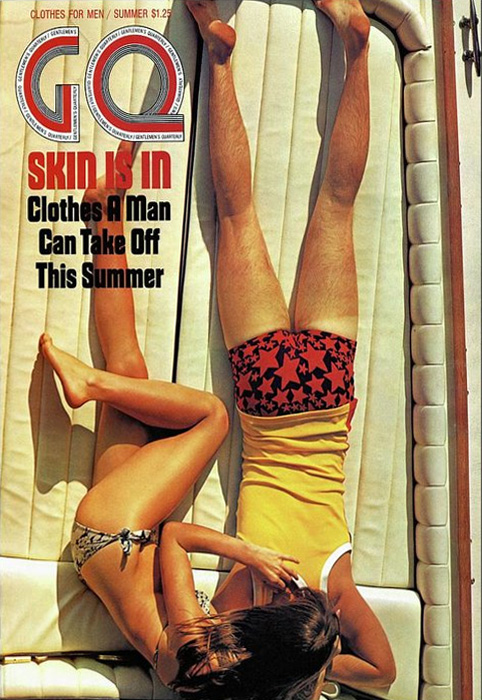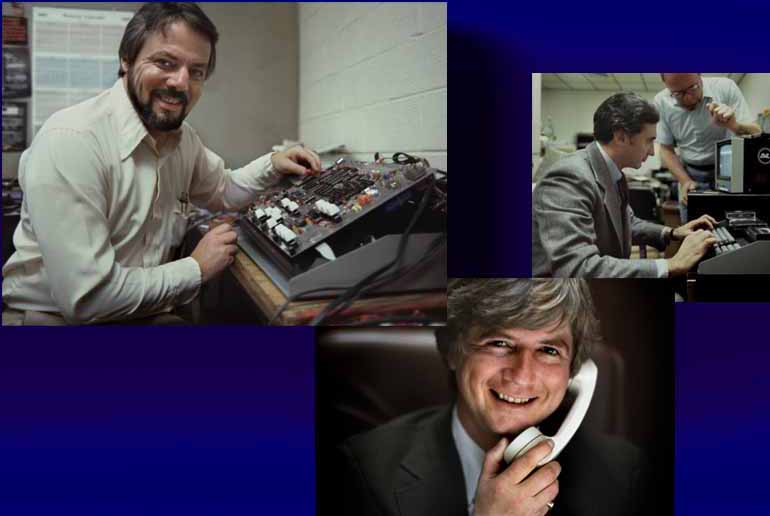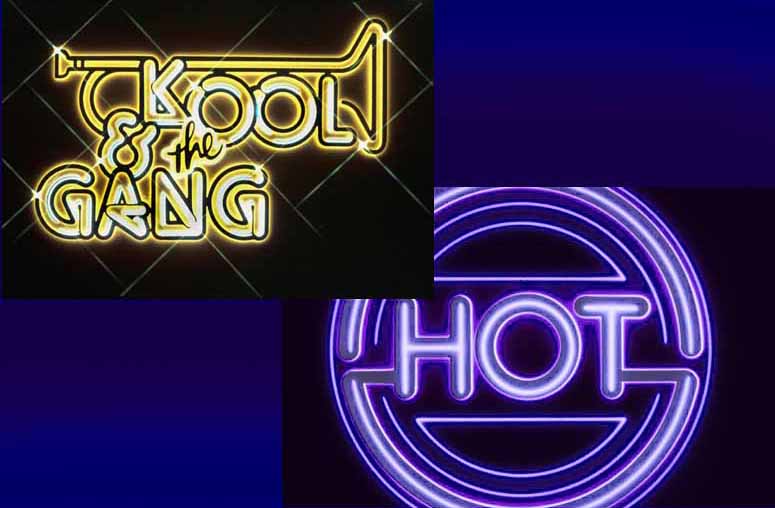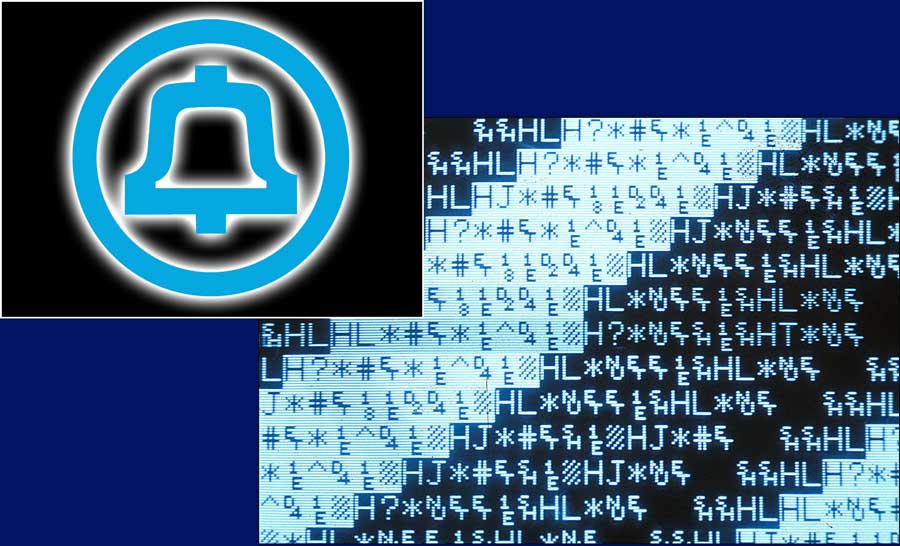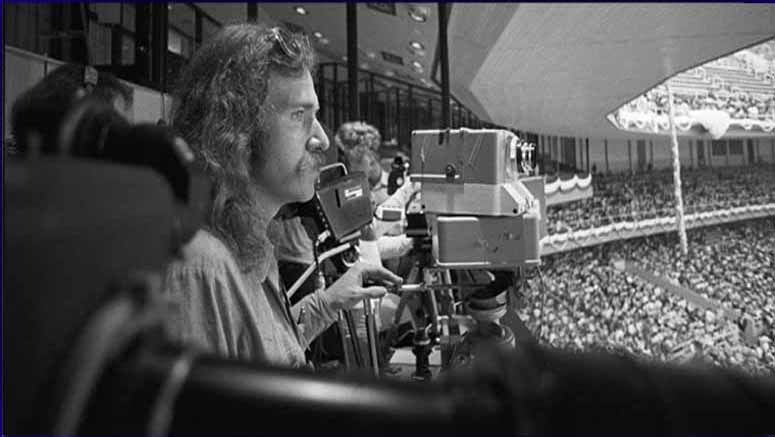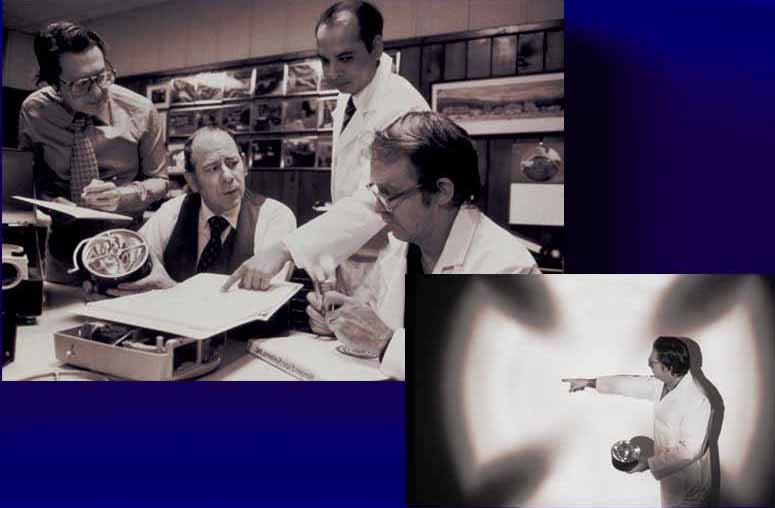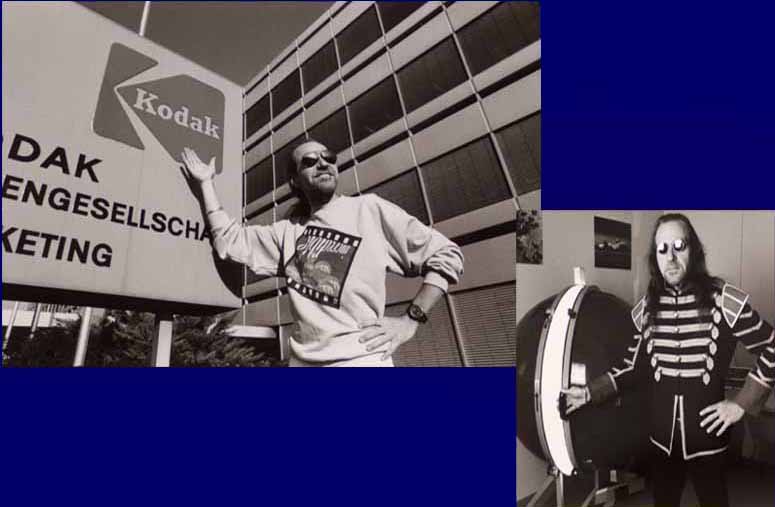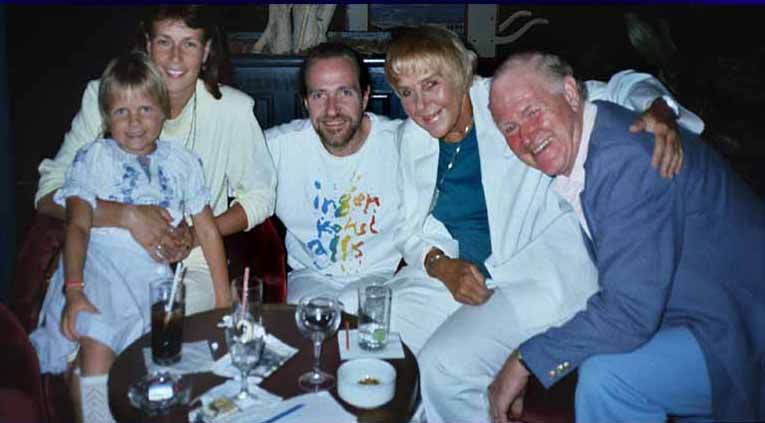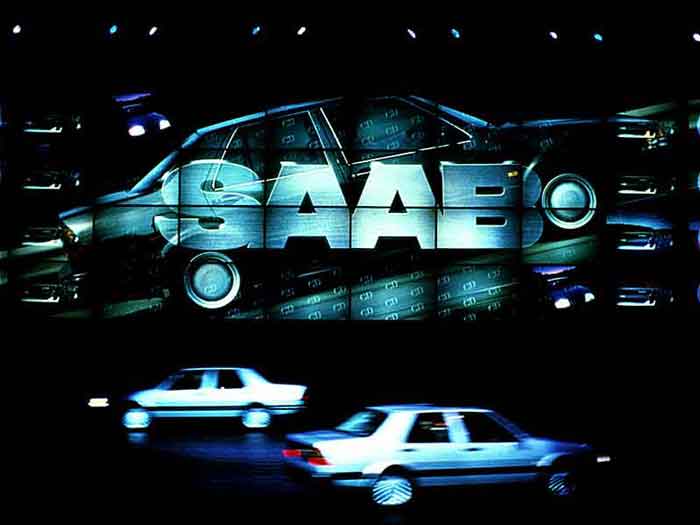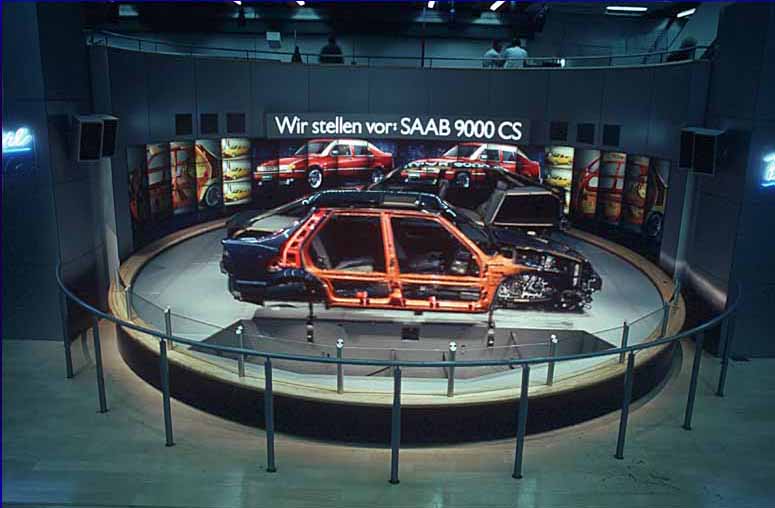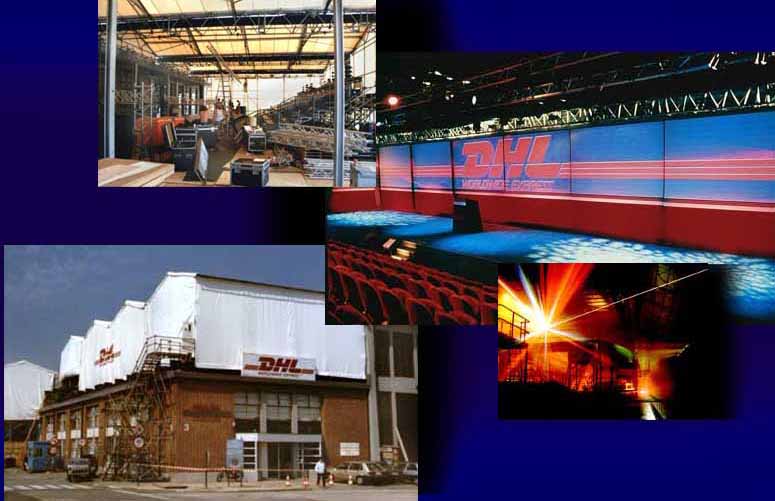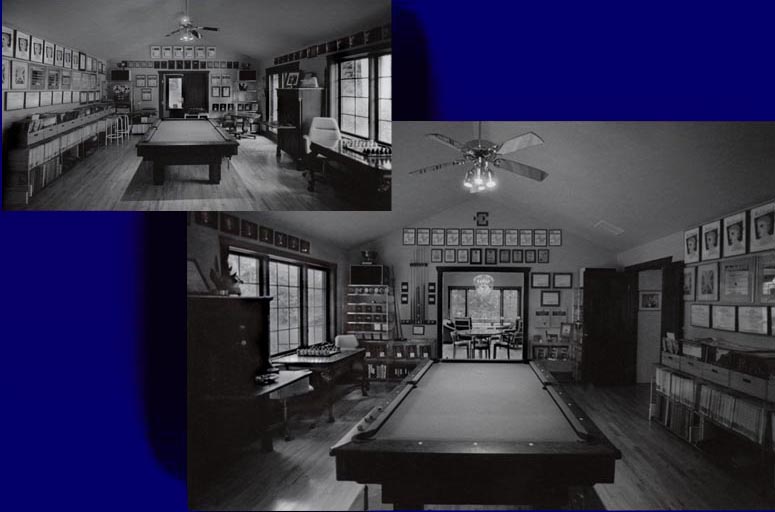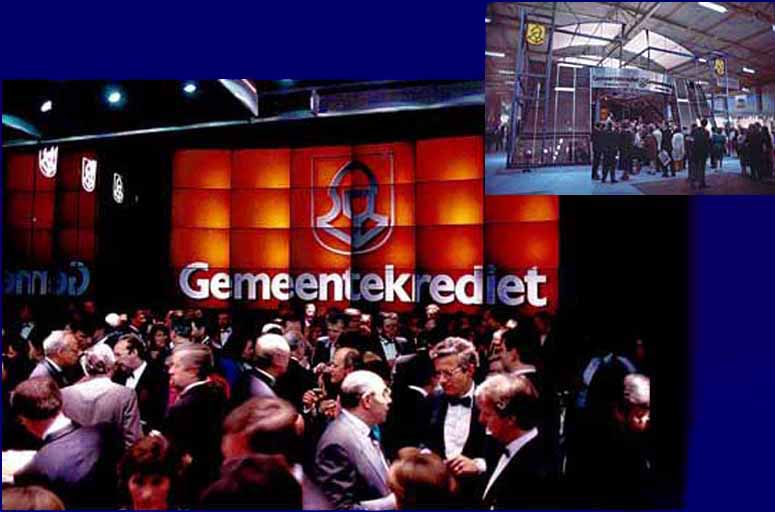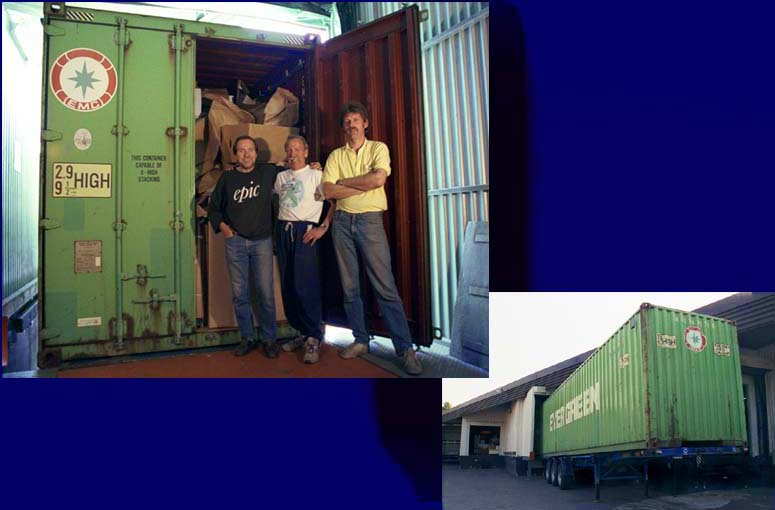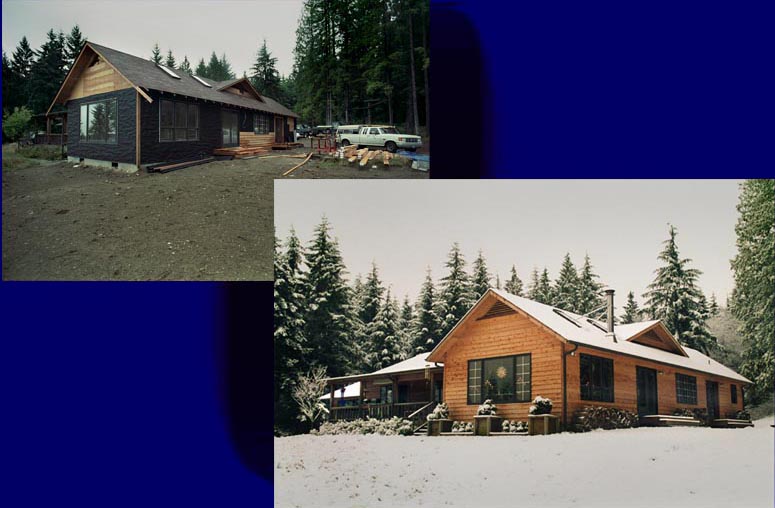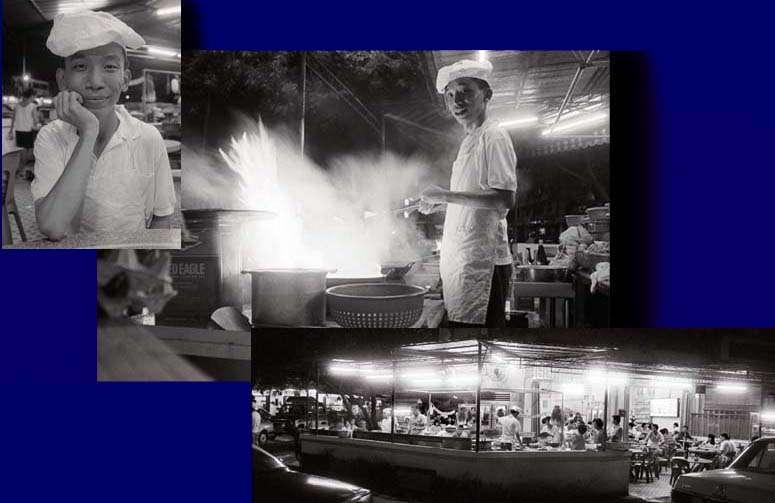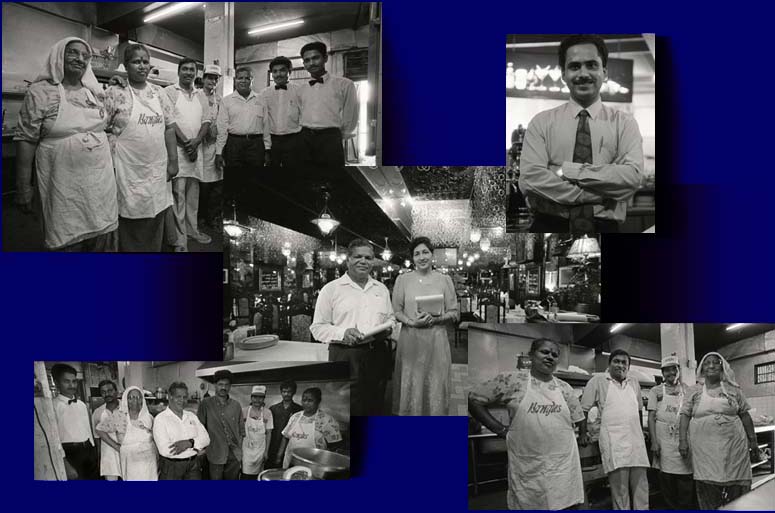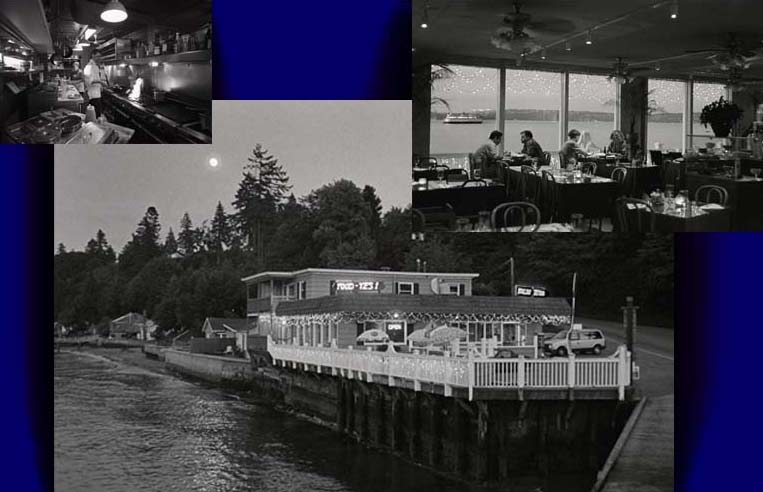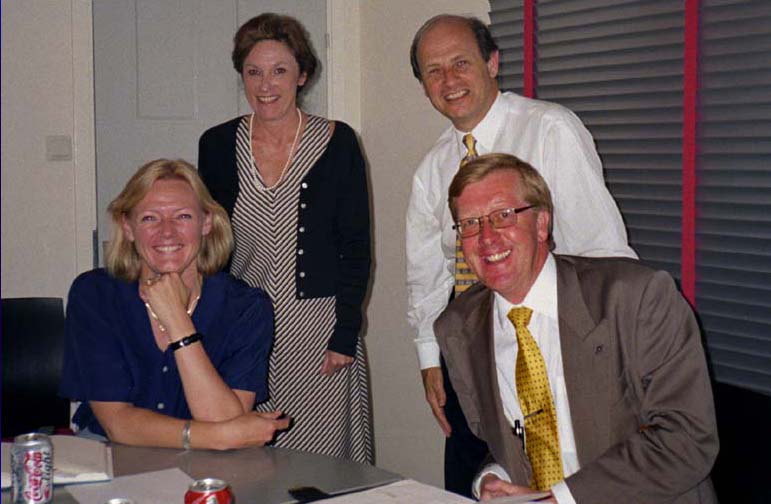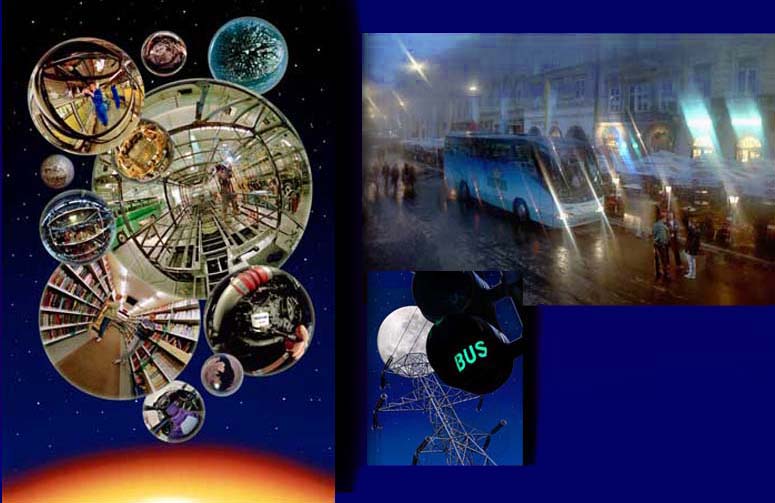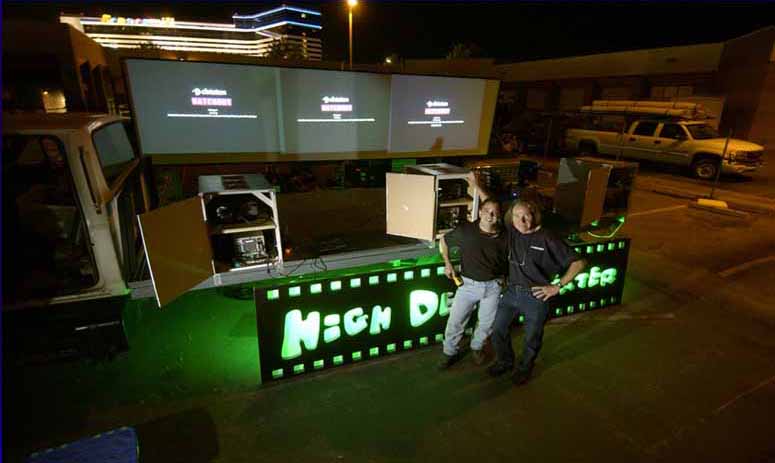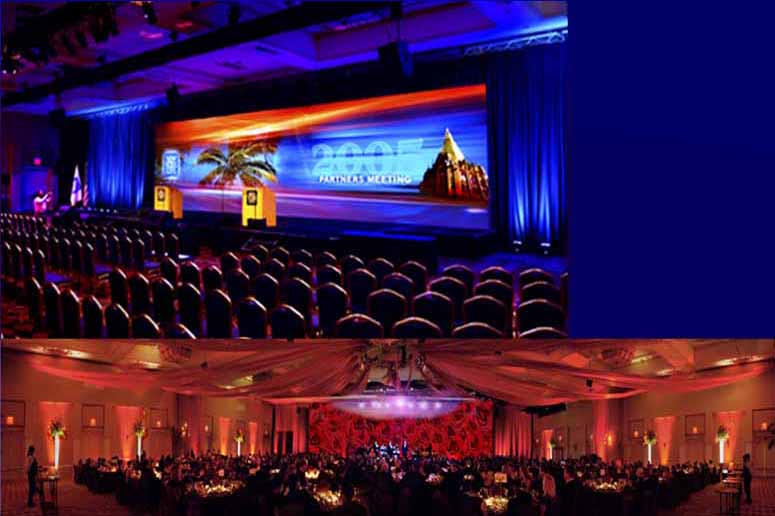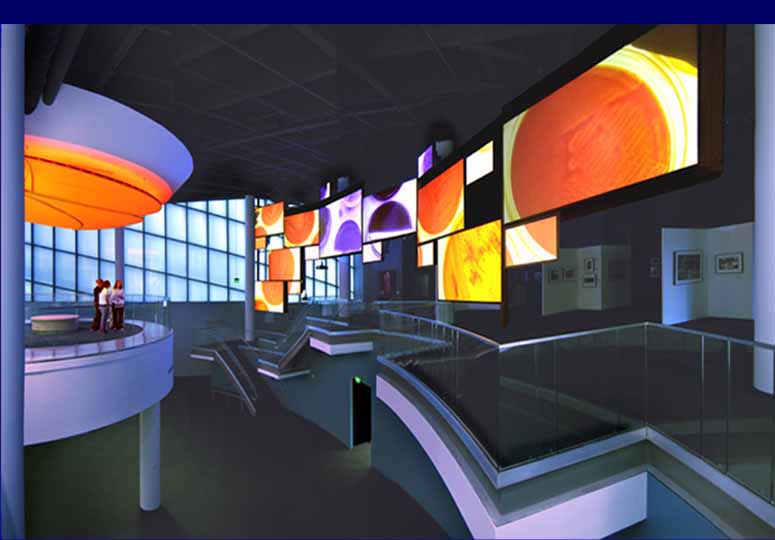INCREDIBLE IMAGESSlides were the DNA of Incredible Images - real slides, the kind made of film. Originally, the company was called The Incredible Slidemakers, and for a good reason: most people who saw our work usually exclaimed, “That’s incredible!” Show DirectorySlide Shows & Films: 1975-1990
Digital (Watchout) Slide Shows: 2000-2007
|
||||||||||||||||||||||||||||||||||||||||||||
|
||||||||||||||||||||||||||||||||||||||||||||
|
||||||||||||||||||||||||||||||||||||||||||||
Incredible Poster: The Incredible Slidemakers pioneered production techniques for optical special effects; and what started as a mistake, changed everything. A few short years after the release of Bumbles everyone was playing with slide animation; and at our shop, we kept pushing the envelope.Audiovisual business rapidly filled the 60% collapse in my print business following the 1973 oil embargo; within two years we were neither a photo studio nor a print-graphics shop; we were making slides and slide shows. In the midst of the transition, Tom Ridinger left (there was so little publication work); Pat Billings came on board, to help in show production; Fred Cannizzaro was hired, to run what came to be our special effects slides department; and the company was renamed, The Incredible Slidemakers.
Incredible Images Slidemakers Logo
Pat Billings setting up a three-screen, eighteen projector show, made by Incredible Slidemakers for Cincom Systems, an enterprise software developer. [https://en.wikipedia.org/wiki/Cincom_Systems]
Top: Grace Napoleon in the slide library at Incredible Slidemakers studio. Bottom: Rocky Grazziano and Grace Napoleon with two others, sitting around the main light-table, where slides were cleaned and mounted. |
||||||||||||||||||||||||||||||||||||||||||||
AT&T | Bell System
AT&T Logo and Monitor Display Code - 1978Dataphone II [Note: I apologize for the poor visual quality of this video; it was made from U-Matic-format (aka ¾-inch) tape that was dubbed from a U-Matic “master” recorded by a prosumer-grade JVC video camera, at the Incredible Slidemakers studio in New York, as the slide show played on a white wall ‘screen’—a so-called ‘off-the-wall’ transfer—nearly fifty-years ago. I also apologize for the obnoxious copyright notice.] Concept, design, principal photography and choreography (programming) by Douglas Mesney | Opticals and visual effects by The Incredible Slidemakers, principally: Fred Cannizzaro, John Leicmon, Jim Casey, Tim Sali, Bob Smith | Further information at mesney.com |
||||||||||||||||||||||||||||||||||||||||||||
Dataphone II |
||||||||||||||||||||||||||||||||||||||||||||
STS - SLIDE TRANSFER SERVICE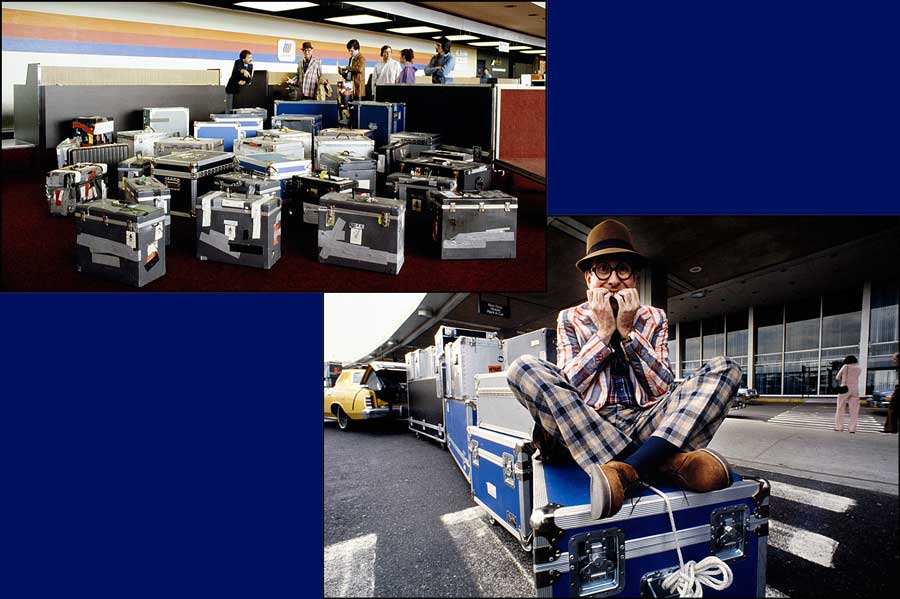 1976 Nightmare Collage[Note: I apologize for the poor visual quality of this video. It is NOT an STS transfer (none of those tapes could be found). It was made from U-Matic-format (aka ¾-inch) tape that was dubbed from a U-Matic “master” recorded by a prosumer-grade JVC video camera, at the Incredible Slidemakers studio in New York, as the slide show played on a white wall ‘screen’—a so-called ‘off-the-wall’ transfer—nearly fifty-years ago. I also apologize for the obnoxious copyright notice.] Concept, script, design, principal photography and choreography (programming) by Douglas Mesney | Opticals and visual effects by The Incredible Slidemakers, principally: Fred Cannizzaro, John Leicmon, Jim Casey, Tim Sali, Bob Smith | Further information at mesney.com. Read more about multiplexers in Volume Three of An Incredible Epic, pages 426-432; and about the show on pages 432-435, here. |
||||||||||||||||||||||||||||||||||||||||||||
|
Nightmares |
||||||||||||||||||||||||||||||||||||||||||||
With our new emphasis on slide shows, the company grew from three people to more than thirty is less than five years; we expanded from one to four floors (five if you include the basement), at the 73rd Street studio. But as Paul Volker put the brakes on the economy, my business failed; I hadn’t planned for a downturn; I though that the business graph would look like a hockey stick forever; boy, was I wrong. The end, for me, was 1981 when inflation was running rampant; when interest rates hit 20%; when Paul Volker put the kibosh on the economy; when credit tightened up and, with it, business in general. At most companies, big, expensive presentations went on the budget-chopping block; my phone stopped ringing; many of the projects we had got cancelled; proposals never materialized.
Moving...
Seeing the handwriting on the wall, I decided to close the shop and move to Honolulu; I reckoned that Hawaii was closer to Japan—a cooking economy investing heavily in Hawaiian real estate, creating (I incorrectly thought) opportunities for multi-image show business.To promote Hawaiian business, I produced the demo show Hawaii Xanadu; it was to be the swan-song for The Incredible Slidemakers; I wanted it to be a sensation. Taking a page out of P.T. Barnum’s book, I decided to make a show that “turned the sublime into the ridiculous” by using 30-projectors on a single screen to create a “mind blower” that presented 2,400 slides in about 3 minutes, accompanied by the popular song Xanadu, sung by Olivia Newton-John. I thought that, at very least, I will hold the land speed record for slides. Ha! |
||||||||||||||||||||||||||||||||||||||||||||
Monique Kaeo was the star of “Xanadu;” we met at Honolulu airport the night that I arrived; her boy friend stood her up and my chauffer was a no show; we found ourselves to be the last two people at the airport, and took things from there.In 1977, when I presented the first animated slide show—Bumbles—at the Association for Mutli Image [AMI] slide show competition, that changed everything; in short order, animated slides and special effects became all the rage; the techniques and styles pioneered by Incredible Slidemakers were copied by countless other producers. Three years later, in 1980, when inflation peaked and the bottom dropped out of the slide-show market, I threw in the towel, closed the company, and moved to Hawaii. Hawaii-Xanadu was my swansong, the last show produced by Incredible Slidemakers, New York; it was made under duress; my workers were upset with me, for closing the company. The show was built from out-takes of Hawaii pictures made for a Rank Xerox sales-contest-promotion show produced by Purchasepoint, London.My goal was to produce a show that was one for the record books; 15-projector, single screen shows had become almost ubiquitous, so I decided to double that, and used 30; for “more sport” the show was made with exactly enough slides (2,400) to fill all 80 slots in each of the thirty slide trays; in that way, the show would end at its beginning, there was no need to reset anything, it could be played as an endless loop. |
||||||||||||||||||||||||||||||||||||||||||||
|
THE INCREDIBLE SLIDEMAKERSDesigned, directed, photographed and programmed by Douglas Mesney. Opticals and effects by The Incredible Slidemakers, principally Fred Cannizzaro, John Leicmon, Nicole Smith, Bob Smith, Jim Casey and Mark Strodel. Music © ELO 1980; performed by Olivia Newton-John. More information at www.mesney.com. Hawaii… Xanadu[Note: I apologize for the poor visual quality of this video; it was made from a PAL-format (European) VHS tape that was copied from an ancient NTSC-format U-matic tape, recorded by a prosumer-grade JVC video camera, at Incredible Slidemakers studio in New York, as the slide show played on a white wall “screen.”]Hawaii – Xanadu was produced under duress, as the studio was working against a tight closing down schedule, and fully half the staff (who were left) were not happy about the shuttering of the shop. “Xanadu” turned out to be the second most-awarded show in AV history (the first being the IKEA show, Building It Is Half the Fun!).
Douglas Mesney (right) receiving Best of [Photokina] Show award from Victor Lawrence, President of the Association for Multi-Image [AMI]
Xanadu garnered gold at the New York International Film & TV Festival.
Center: Douglas Mesney (left) being toasted by his father (partially hidden) and Swedish producer (and fellow award winner) Bjorn Ericstam, while Mrs. Mesney tries to get a picture. Upper left: Mesney with Ericstam (right) and Don Sutherland. Lower right: Mesney with Ericstam and his mother.
The last man standing was Jon Bromberg, an indomitable bull dog who got things done and went on to get things done for Staging Techniques and Bill Gates after getting everything packed into a forty-foot container destined for Honolulu, along with me. It would be the beginning of a 20-year odyssey, working my way around the world as a free-lance consultant to other multi-image production companies.My plan for a multi-image production company didn’t work out; I should have realized that no producer would hire a sub-contractor in Hawaii, when they wanted to go there themselves. As the bank account dwindled, I turned to making ‘tourist pictures’ using a rare 360-degree camera called the Cyclopan, developed by Jack Rankin, who built ten prototypes, of which I became the owner of serial number 1003.
Yours truly with the Cyclopan camera at Yankee Stadium shooting a rally held by Reverend Sun Myung Moon. Let’s see... 20,000 people times $15.00 per print... hmm! I suspect that Pat Shipps (at the time, Pat Billings) took this shot.
My (then) wife, Sandra Sande, and I started a business called Hawaiian Panoramas; the idea being to make art for galleries and deluxe, “coffee-table” picture books, featuring scenic panoramas of Hawaii’s premier destinations, made with our “one-of-a-kind” camera. Well, we never made any money, but producing Hawaiian Panoramas got Sandra Sande and I to the best spots on all the islands, chasing perfect sunsets… a priceless experience.Did I tell you that I think I have a lucky star? That’s because every time I have gone bust, the phone has rung, always with a new opportunity; and so, it was, as the tide of my fortunes went out, in Hawaii. Lindsay Rodda at Sonar Graphics, in Melbourne, Australia, called me to ask if I would oversee the production of car-launch shows for both Ford and Holden (GM Australia)—and train his staff in the process. It was there that I met, and convinced Lindsay to hire, John Emms,; a masterful technical photographer, as head of the rostrum camera department; it was a big change for John, involving an entirely new camera technology, that he would soon master, later becoming my production partner in a Swedish venture called Incredible Imagers AB.
Top right: Sandra Sande. Top left: (L to R) Bette Murray, Lindsay Rodda, Sandra Sande. Bottom: Lindsay Rodda.After a year down under, we returned to Honolulu and resumed Hawaiian Panoramas, but tourism was way off due to the business “hangover” after Volker’s draconian credit tightening, and we found ourselves slowly going broke again until, once again, the phone rang. This time, it was Chris Korody on the line, calling from Image Stream, his internationally- recognized multi-image production company, in Los Angeles; they were over booked and staffing up. I ended up there for a couple of years, and manages to convince Chris to bring in John Emms from Australia, to run the Maron Carrell rostrum camera department, which has a position he held until Image Stream went under in 1985, another victim of “Volkerism.”
Top left: Chris Korody landing a big one. Bottom right: the scene at Las Vegas’ MGM Grand Hotel, where the 1983 Yamaha sales meeting was staged by Image Stream. Screen graphics were designed by Bill Aylward.My days at Image Stream were among the happiest, professionally. His staff was more capable and more motivated than any I have ever seen, anywhere; everyone had everyone else covered; so you could do your thing and everyone wanted to help you… and you wanted to help them; it was truly a team, with a strong and opinionated leader. While at Image Stream, I programmed and oversaw the production of shows for a Yamaha new-model introduction, as well as the Quazite Product Launch, (Quazite is a polymer-concrete material). SHELL OIL COMPANYPIX – Quazite graphic by Bill Aylward Quazite was the first show that I produced at Image Stream, in 1983; the show benefited considerably from Bill Aylward’s slick graphics. Before he learned of my availability, Chris Korody, Image Stream’s founder and head honcho, had already booked Robert Pelton to do the Shell show; so, when I arrived, Pelton and I started off co-producing the show. Pelton, who wrote the script, was also a photographer; he had a journalistic bent that blended well with my documentary style; between the two of us, it became obvious that the visual solution for the show was documentary photography, spiced up with Image Stream’s slick, trademark graphics, designed by Bill Aylward. Although he was no slouch, my talents exceeded Pelton’s, especially programming; so, Pelton eventually relinquished show production to me. I spent two weeks on the road in the U.S. and Canada shooting the documentary, while Pelton shot sequences of refineries in southern California; animations were not his forte. Credits: written by Robert Pelton. Directed, designed and programmed by Douglas Mesney. Graphic design and production by Bill Aylward. Rostrum camera work by Chris Cianciarillo and Ted Iserman. Audio design and production by Brad Pinkstaff at Silverlake Studios, L.A. More information at www.mesney.com. SHELL: Quazite[Note: I apologize for the poor visual quality of this video; it was made from a PAL-format (European) VHS tape that was copied from a Betamax master, since lost, recorded by a prosumer-grade video camera, as the slide show was projected on a white wall “screen” at Image Stream’s studio in Los Angeles.]I was happy at Image Stream, working alongside Chris Korody, another giant in the multi-image business. Sandra and I lived with Chris (and Kathy and their dog, Charlie) for a few weeks until we found our own place; then I got seduced, and then abandoned, by a creative Canadian production house (who shall remain nameless) promising a World’s Fair’s gig working on a monster show for the Air Canada pavilion. After laying out a detailed plan in my proposal, they hired a local producer to execute my plans at a substantially lower rate; so, after moving up to Vancouver, I was suddenly unemployed; the experience taught me (yet again) to never reveal your plans before you get paid. Sandra and I spent a dreary autumn and winter in Vancouver, waiting for the phone to ring. Finally, it did; this time it Sven Lidbeck and Kurt Hjelt, the co-owners of Audio Visual Centrum (AVC), in Stockholm, Sweden, offering a chance to produce the show that would launch the Saab 9000.
Kurt Hjelt (inset and right) and Sven Lidbeck (lower left), the founders of Audio Visual Centrum, in Stockholm, at the company’s summer party; the two brought me to Sweden at the request of Lars Einer, Saab’s advertising manager, to produce the launch show for the Saab 9000 Turbo 16.When the plane touched down in Sweden, it was a late-Spring evening, but it felt like 50 below zero and seemed like we had landed at the end of the Earth. Lasse Hellquist and Kjell Gustavsson picked us up at the airport and took us on a tour of Stockholm, including the Old Town, where they introduced us to “Swedish wine” (aka schnapps) at Gyldene Freyden, an 18th century tavern. AVC at that time was Sweden’s premiere meeting-production company; they had a good multi-image show making facility, with about two dozen people on staff, but they wanted to make it better… an attitude of which I have always approved; so, they imported talent from other countries, particularly England and America, where multi-imagery was the most sophisticated. During my tenure there, I worked alongside Rick Pedolski, another American producer, and together we brought in teams of others from New York and L.A., which fleshed out AVC’s staff to about three dozen. SAABAfter I arrived in Stockholm, in 1984, ready to produce a launch show for the Saab 9000 Turbo 16, a one month delay was announced (the prototype car wasn’t ready); to fill the time, Lars Einar, Saab’s advertising manager, commissioned this show, to announce and celebrate the car brand’s new emblem The assignment was to make a slide show that would also work as a video—for ease of use; I chose a 12-on-one format (12 slide projectors aimed at a single screen) in order to be able to project fast sequences, animated graphics and effects. The Imagery was primarily sourced from the Saab picture library (the most extensive I’ve ever seen). Credits: Written, directed, designed and programmed by Douglas Mesney. Library music & mix by Tommy Bergqvist. Opticals and effects by Andreas Wannike and Filip Järnehag. Optical art by Tim Geyer, Sandra Sande, Rick Gulledge and others. Video SFX end logo provided by Saab America; used at the insistence of the client. More information at www.mesney.com. SAAB: Emblem |
||||||||||||||||||||||||||||||||||||||||||||
Film crew for the Saab 9000 shows, wrapping it up after a week-long shoot in Sweden and Norway. After Lars Einar retired, Thomas Lagerqvist took over (upper left, with his wife, Lena; and to my immediate left—I’m wearing the dark-blue shirt. Former Audio Visual Centrum [AVC] colleagues, Filip Järnehag and Juki Nakamura (extreme right), were part of my team; I was their hero, the guy who survived the demise of AVC. Sorry, but I can’t name the two guys on the extreme left. |
||||||||||||||||||||||||||||||||||||||||||||
Juki Nakamura (left) and I, in Norway, checking the shutter of a 250-exposure Nikon F3 mounted on the bumper of my Saab 900 Turbo 16, to shoot animated slide sequences of other Saab cars blazing down a country road.Sandra Sande and I were supposed to go home, to Vancouver, BC, after the Saab 9000 Turbo 16 world launch show; but Lars Einar, Saab’s advertising manager—my boss client—asked if we would stay and produce two new shows, to be used at the US launch of the Turbo 16. This is the first of the two shows, about the new Saab 9000 range of cars; the other show was about the 900 range. This show used 30 Kodak S-AV projectors—the most that could be controlled by an AVL system (Eagle computer and Dove dissolvers)—aimed to overlap in a panoramic format called “Two-Plus-One;” that is, two side by side images, with a third overlapping the other two, in the center; the format was also called “One-Over-Two. In this case, the left and right screen areas each had six projectors, the remaining eighteen were focused on the center area of the screen. Eighteen projectors were needed to project slide animations at up to six slides per second; they were also needed for sufficient tray space for the 2,400 slides in the show. Written, directed, designed and programmed by Douglas Mesney. Original photography by Saab Studios and AVC’s Bengt Sundalin, shooting beauty shots, as well as myself, Douglas Mesney, assisted by Filip Järnehag and Juki Nakamura, shooting the animated sequences. Library music & mix by Tommy Bergqvist. Narrated by Brad Crandall, recorded at Silverlake Studios by Brad Pinkstaff. Opticals and effects by Filip Järnehag. Optical art by Sandra Sande, Susan and Tim Shields, Rick Gulledge and others. More information at www.mesney.com.
Me, on the Swedish island of Öland, checking alignment of hood-mounted camera.AVC never fully paid me for the Saab 900 and 9000 US shows; they were making a fortune but going broke, having over-expanded in anticipation of a continuing high-level of show production—based on the success and notoriety of the Saab shows—but that never materialized. I didn’t want to leave AVC, and they didn’t want me to leave, but they weren’t paying their bills and, unawares to me, were actually going bankrupt, due to over-staffing and too much overhead. I hadn’t been paid in so long that I couldn’t afford to go home, to Canada; there weren’t any other big AV shops in Sweden to work for [with the possible exception of Producenterna, but they didn’t like my style]; so, the only way to generate money was to compete with AVC, which I did, taking the Saab account with me when I left. Years later, Lars Hellquist told me that he, Bo Stroman, Kurt Hjelte and a few other company directors eventually put up some of their own money, to pay most of my past-due bills; but by then I was gone; I quit AVC and opened Incredible Imagers AB, right across the street; Saab came with me, to the surprise and chagrin of AVC; that triggered further mutinies, as other clients jumped their ship, leaving AVC for my new company. The money we earned for our Saab shows, together with the prestige of producing them and the publicity we generated, put Incredible Imagers on the map; we started getting calls from central Europe and working for clients in Belgium (Colgate & DHL) and Germany (Kodak & Mercedes Benz). One of the first projects we did was a new demo show for Audio Visual Laboratories. Technologically, it was the most complicated show I ever produced; I am amazed that rostrum-cameraman John Emms didn’t mutiny; but, like me, he was a glutton for punishment; the harder it got the more we loved it; we knew that nobody else would go this far, that we would achieve another “first” in the world of multi-image, which is exactly what AVL demo shows were supposed to do. The difficulty lay in the complexity; inside every Wess slide mount was a “sandwich” composed of three chips of film—the image, a soft-edge mask, and either a reveal mask or a clear chip, called an “alpha,” replacing it; so that each sandwich had three slices; so that each would be equally thick; so that each would focus at the same point; so that none would look “soft” (unsharp) on the screen. Not only did triple-chipping triple the costs, it quadrupled the frustration during slide assembly; it was much harder to clean those slides, to keep dust from lodging between all those layers; and, to top it off, we produced three sets of the show: two for AVL and another for us, to use as an Incredible Imagers demo, and enter into competition. [It won its share of gold in the 1988-89 competition circuit.] |
||||||||||||||||||||||||||||||||||||||||||||
AVL - Audio Visual Laboratories
1976 - You Can't Stop a Dove - Show FinaleYou Can’t Stop a Dove! NOTE: THIS SHOW STARTS IN BLACK; sound only for the first few spoken lines. You Can’t Stop a Dove! was made in 1978 by New York’s Incredible Slidemakers. The show was rescued from a storage locker and brought back to life by Steve Michelsen, who has put together what could be the last operating multi-projector slide show rig in existence. Nine Kodak slide projectors were used to create the animated effects and they are pushed to maximum speed during the long, animations. Some reprogramming was involved, because Steve’s Kodak newer E3 projectors don’t advance slides as quickly as the B2 models used to produce the original show, nearly fifty years ago. Although several dozen slides were removed, the show looks virtually the same as it used to – except for the faded colors, for which nothing can be done. That story can be found on page 2567 in Volume Nine of An Incredible Epic, here. AVL toured the show internationally to demonstrate their gear and to solve a problem: The year before, the company’s new, “QD” digital dissolve units (used to blend two or more images) were subject to glitches and didn’t reliably execute the instructions given by the master-control computer. Producers complained of their shows going wild, as if the projectors had minds of their own. The show satirizes that situation. Claiming that ‘you can’t stop a Dove,’ an AVL dealer presents the Dove demo show to a dubious prospect, who tries to stop the Dove—i.e., lose its memory and get out of synch. Enraged by the Dove’s recovery to all his tricks, the prospect axes the Dove saying, “Guess what? Your Dove just stopped!” Meanwhile, the show within the show presents the Dove’s features and benefits. Read the full story on page 467 in Volume Three of An Incredible Epic, here. The on-screen role of the frustrated producer was played by Charlie Spataro, AVL’s number-one dealer. And, in another touch of irony, the crowd watching aghast as the Dove is axed included AVL’s top sales people and some of the most well-known, award-winning, slide-show producers, including David Fellowes and Allan Kozlowski. Read the full story on page 467 in Volume Three of An Incredible Epic, here: The show was well received, winning a gold award at the Vail International Multi-Image Festival as well as gold and Best of Show awards at the Information Film Producers Association (IFPA) competition, while propelling the Dove to the most popular slide dissolve machine ever made. |
||||||||||||||||||||||||||||||||||||||||||||
AVL: Rhythms of the WorldThis 15-projector slide show was made by Incredible Imagers AB, Stockholm, in 1986. The show was programmed using AVL’s Eagle computer and Dove dissolve units (dissolvers). The show was used at meetings, events and trade shows to demonstrate the programming proficiency of AVL equipment; the demo was co-sponsored by The Stock Market, one of New York’s top picture agencies [since absorbed by Bill Gates’ Corbis picture agency] to show off their extensive range of stock photography. The success of the show hinged on John Emms’ mastery of the Marron Carrel 1600 rostrum camera; the show also demo’d Master Masks, a picture-masking system designed by yours truly to “reveal” pictures using unique shapes, ie., starburst, lightning bolt, spiral, etceteras, inspired by 1930s and 40s Hollywood-movie trailers. Credits: Written and designed by Douglas Mesney at Incredible Imagers’ Stockholm studio, in 1986. Opticals and visual effects by John Emms. Music by Geoff Levin at GLMC Studios, L.A. [lyrics © Mesney]. Further information at www.mesney.com
AVL: Rhythms of the World[Note: I apologize for the poor visual quality of this video; it was made from a PAL-format (European) VHS tape that was copied from a Betamax master, since lost, recorded by a prosumer-grade video camera, as the slide show was projected on a white wall “screen.”] |
||||||||||||||||||||||||||||||||||||||||||||
Bergen Expo
Left: Lab technicians show plans for the QPLV xenon projector to Gene Demmick (wearing vest), Founder and CEO of Bergen Expo. Right: a technician points to the projector lamp’s light pattern. Both pictures are scenes from the show, which was in color—these are black-and-white publicity prints that were sent to the press.“See the Light!” was a three-projector slide show made in 1986 by Incredible Imagers AB (Stockholm) to demonstrate the proficiencies (especially flashing effects) of Bergen Expo’s blazingly bright QPLV—Quadra-Point Light Valve—xenon-lamp slide projector. The show was primarily used at trade shows, as a “table-top” display. [In an age when companies were using up to one hundred projectors, a three-projector slide show was considered small.] It was a gold-medal winner at AMI (Association for Multi-Image) and most other major slide show competitions; nobody had packed so much action into a small show before. Credits: Written and designed by Douglas Mesney at Incredible Imagers’s Stockholm studio in 1986. Opticals and visual effects by John Emms. Music by Geoff Levin at GLMC Studios, L.A. [melody & lyrics © Mesney]. Further information at www.mesney.com Bergen: See the Light[Note: I apologize for the poor visual quality of this video; it was made from a PAL-format (European) VHS tape that was copied from a Betamax master, since lost, recorded by a prosumer-grade video camera, as the slide show was projected on a white wall “screen” at Incredible Imagers studio in Stockholm, Sweden.] |
||||||||||||||||||||||||||||||||||||||||||||
KODAK
Left: yours truly at the Kodak factory in Stuttgart, German. Right: dressed in Sergeant Pepper attire, about to open an illuminated pod containing an S-AV projector.This is a three-projector slide show [a two-projector version was also made] produced in 1989, by Incredible Imagers, Stockholm. The show was made to commemorate the one-millionth Kodak S-AV slide projector. Fifty copies of this show were released, worldwide. It was made at when the demand for multi-image shows was peaking; a time when everyone, it seemed, wanted in on the action. But for Kodak, the market was problematic: producers everywhere were already geared-up. To keep their Stuttgart [Germany] factories busy, Kodak needed to find new customers; they wanted a show demonstrating that a lot could be done with as little as two or three projectors, to encourage beginners to get involved with slide shows and attract media producers in emerging markets. Built when many companies used up to 100 slide projectors to make audiovisual extravaganzas, this show aimed to do “more with less.”
Scenes from Got to Be, S-AV! Top Row: Martin Luther King holding a sheet of slides 9left); Charles De Gaulle with a vintage 20s Kodak slide projector (center); Fidel Castro clutching a box of slides and a viewer. Bottom row: Nikita Kruschev with a 30s projector (left); Peter Sellers and May Britt holding a sheet of slides (center); President Kennedy examining a slide (right).Credits: Written, designed, directed, programmed by, and starring, Douglas Mesney. Principle photography by Chris Hall (London). Opticals and effects by John Emms assisted by Conny Bergqvist. Thanks to the late Peter Grunert, my Kodak champion, a fellow AV guerilla. More information at www.mesney.com. Kodak: Got to Be S-AV!In addition to our new business from AVL, Kodak and Bergen, Saab, my most faithful of all clients [rivalling Arnie Miller] delivered a job that dwarfed every show I had ever produced. It was the first time I ever heard Lars Einar say, “…don’t think about the money;” this show was his swan song, an extravaganza promoting the biggest gamble the company had ever undertaken—the metamorphosis from a builder of utilitarian vehicles to luxury cars; the company would live or die on the success of this launch; in some ways, it was even more important that the launch of the first Saab 9000 three years earlier; with that car Saab penetrated BMW and Audi markets; this new one was aimed at the luxurious limo market. |
||||||||||||||||||||||||||||||||||||||||||||
SAAB: 9000 CD World Launch
A troupe of fifty British singers and dancers performed a hour-long pageant celebrating the history of the “sedan” (a moving chair) from the days of human carriage, to horse-drawn carriages, to motorized vehicles. The show was written by Hans Hjiort and performed by the Stockholm Symphony Orchestra. This scene opens the show, in Egypt, thousands of years ago.A huge screen was needed for the giant stage at the Acropolis, the biggest convention center on the Côte D’Azur. However, hampered by limited projection “throw” distance (between projector and screen) projecting a big picture required a matrix of small screens; that requirement dictated the specifications for Incredible’s first Image Wall screen; the name derived from “video wall,” a then-popular, multi-screen grid of video monitors, used by show designers to create big TV images.
Upper left: Saab delegates and VIPs from around the world filled all 2,500 seaths in the Appolon Theater at the Palais des Congrès Acropolis theater in Nice, France. Lower left: Stockholm Symphony Orchestra played an original score by Hans Hiort for an hour-long extravaganza of song and dance, celebrating the history of the carriage, performed by a troupe of fifty. Right: From backstage, AV journalist Don Sutherland photographs the installation of Incredible’s 40-panel Image Wall screen.Our Image wall was composed of 40 panels, each 3 X 2 meters [9.84 X 6.56 feet], arranged 10 panels wide by four high; the total screen size was 90.84 X 26.04 feet [30 X 8 meters]. Two projectors were aimed at each of the 40 panels; thus, screen images were illuminated by 40 projectors, making them very bright, and able to compete with a battery of stage lights illuminating elaborate song and dance routines by a troupe of 50 singers and dancers. The eighty projectors (40 panels @ 2 each) were programmed using four AVL Genesis computers and forty Super Dove dissolvers. Anecdotally speaking, I was the AVL dealer in Sweden; I sold myself so much gear for this show that I won AVL’s sales competition; the prize was a Jamaica cruise with the audiovisual élite, hosted by AVL’s CEO, Ray Sozzi.
I flew my parents (Dorothy and Peter, right) to Nice, France, from New York, to see the Saab spectacular; on the left, Elisabeth Ivarsson—my sambo and Incredible’s office manager, with her daughter, Anna. My shirt is emblazoned with a Swedish play on words: Ingen Konst Alls means “No Art At All” if translated literally; in Swedish slang it also means “Nothing To It!”Credits: The 40-panel Image Wall screen was built built and staged by Dillens & Dillens [D&D], in Brussels, principally by Dirk Van Even, D&D’s Technical Director. Written, designed, directed and programmed by Douglas Mesney. Principle photography by Saab Studios, Sten Granath, and Douglas Mesney, assisted by Filip Järnehag and Yuki Nakamura. . Opticals and effects by John Emms assisted by Conny Bergqvist. Further information at www.mesney.com Saab: 9000 CD World Launch[Note: I apologize for the poor visual quality of this video; it was made from a PAL-format (European) VHS tape that was copied from a Betamax master, since lost, recorded by a prosumer-grade video camera, during a performance of the show at the Acropolis convention center, in Nice, France.]
The new cars drove out from under the Image Wall screen; this shot provides the perspective that reveals the side of the Image Wall screen—and why such a big screen was needed.
Upper left: the new cars drove out from under the Image Wall screen. Upper and lower right: 50 singers and dancers performed in front of the screen.
Saab’s trade-show-stand designer, Lars Sundquist, picked-up on my Image Wall concept; he included a 40-panel, 80-projector installation to provide semi-circular, 180-degree backgrounds for a revolving-turntable-display of a Saab 9000 Turbo 16, as seen here at the Frankfurt Motor Show in 1991. I used a Swiss-made panorama camera to shoot 180-degree scenes of beautiful highways and byways in Norway, assisted by Filip Järnehag.
Here’s a smaller, 24-panel Image Wall, at the 1991 Tokyo Motor Show. Meanwhile, I was making a living, thanks to Saab, producing Image Wall backgrounds for Saab-car displays at International Motor Shows throughout Europe and Asia. That was lucrative business; in short order, I stashed enough to pay my way back to the States. The new plan was to start over in America, to use money made producing AV shows to open a restaurant or bakery.Credits: Written, designed, directed and programmed by Douglas Mesney. Principle studio photography was by Saab Studios, Sten Granath, and Douglas Mesney, assisted by Filip Järnehag and Yuki Nakamura. Opticals and effects were by John Emms assisted by Conny Bergqvist. Further information at www.mesney.com SAAB: 9000 CD World Launch - Reveal of Car[Note: I apologize for the poor visual quality of this video; it was made from a PAL-format (European) VHS tape that was copied from a Betamax master, since lost, recorded by a prosumer-grade video camera, during a performance of the show at the Acropolis convention center, in Nice, France.] |
||||||||||||||||||||||||||||||||||||||||||||
SAAB: Putting the Future in MotionThis twelve-projector, single screen Saab show, together with the twelve-on-one “Enginuity” show, represent the apex of Incredible Imagers achievements—the collaboration of John Emms and I; we initially worked together at Lindsay Rodda’s company, SonarGraphics, in Melbourne, Australia, in 1981; now, six years later, we had innate insights into each other; we understood and enhanced each other’s styles; you can see it in the controlled smoothness of the animations, precisely choreographed to the script and music. Credits: Written, designed, directed and programmed by Douglas Mesney. Principle photography by Sten Granath and Douglas Mesney. Opticals and effects by John Emms. Library music, audio design, mix by Douglas Mesney. More information at www.mesney.com. SAAB: Putting the Future in Motion[Note: I apologize for the poor visual quality of this video; it was made from a PAL-format (European) VHS tape that was copied from a Betamax master, since lost, recorded by a prosumer-grade video camera, as the slide show was projected on a white wall “screen” at Incredible Imager’s studio in Stockholm, Sweden.] |
||||||||||||||||||||||||||||||||||||||||||||
SCANIA: The Power of Scania
Douglas Mesney in programming studio (left) and in audio suite (right) at Incredible Imagers Stockholm studio; photos were shot for Kodak Got to Be S-AV! show.This was one of my favorite shows; I got a chance to write a song. In the mid-80s I took control of audio production at Incredible Imagers; I bought a ton of gear and became self-sufficient, for the control more than the money. Good theme songs have power; that’s something I learned from Chris Korody, at Image Stream, who wrote the Apple Boogie for Steve Jobs; theme songs are inspirational and motivational—qualities you want, in a slide show (any show). The Power of Scania became Scania’s rallying song; after being introduced with this slide show, the song went on to be used at trade shows, launch events, company meetings, and at dealerships in more than fifty countries. Visually, the show is a bit of a hodgepodge; we relied heavily on the Scania archive; although it was the most complete corporate picture library I have ever seen, and each picture was of excellent quality, it was difficult to find a visual red thread from the disparate styles of a hundred different photographers. I shot a bunch of original stuff to act as a kind of visual glue, holding together the melange of library images; I was heavily into using “fruit cake” filters, to create starburst, rainbow, and multi-image “prism” effects; I worked with a set of several hundred filters.
I travelled with fifteen cases of gear; the third row down shows the four cases carrying my filter set.Credits: Written, designed, directed, photographed and programmed by Douglas Mesney. Music theme and lyrics by Douglas Mesney; produced by Geoff Levin Music, Los Angeles. Opticals and effects by John Emms. More information at www.mesney.com. SCANIA: The Power of Scania[Note: I apologize for the poor visual quality of this video; it was made from a PAL-format (European) VHS tape that was copied from a Betamax master, since lost, recorded by a prosumer-grade video camera, as the slide show was projected on a white wall “screen” at Incredible Imager’s studio in Stockholm, Sweden.] |
||||||||||||||||||||||||||||||||||||||||||||
SWEDEN TOURISM BOARD“Swedish Meatballs”
Lars “Lasse” Haldenberg starred as the Swedish Chef in a play on the Muppets’ character, for the 18-projector, single-screen, slide show, “Swedish Meatballs,” produced by Incredible Imagers, Stockholm.This show turned out to be a major embarrassment, for me as well as the Swedish nation; at least, that was how the King of Sweden characterized it, after seeing it at an approval session; by then it was too late to make anything other than small changes, before the show went on a six-month tour across America, part of a major trade mission celebrating the 150th anniversary of the Swedish migration to America. Americans don’t know much about Sweden; but most recognize the Swedish Chef, one of the Muppets’ characters; they also recognized Burt Wolf, CNN’s food editor, who traveled the world, reporting on international national cuisines. So, I wrote a show around those two characters; Burt Wolf interviews the Swedish Chef; as things go wrong, Wolf cuts away to interesting Swedish factoids.
Douglas Mesney on camera at Grand Hotel, assisted by Filip Järnehag (left) and Juki Nakamura (extreme right); the hotel manager (center) couldn’t believe what was going on.Written, designed, directed and programmed by Douglas Mesney. Principle photography by Douglas Mesney, assisted by Elisabeth Ivarsson, Filip Järnehag and Juki Nakamura. Burt Wolf played himself—don’t even ask, how much it cost to bring him to Sweden for a week and put him up at the Grand Hotel. Ha! Sven “Tummin” Svensson played the Swedish Chef. Photographed at the Grand Hotel, Stockholm, Sweden. Audio recording by Roger Brett at Music City Media, Stockholm; soundscape design and production by Douglas Mesney at Incredible Imagers, Stockholm. More information at www.mesney.com. Swedish Meatballs[Note: I apologize for the poor visual quality of this video; it was made from a PAL-format (European) VHS tape that was copied from a Betamax master, since lost, recorded by a prosumer-grade video camera, as the slide show was projected on a white wall “screen” at Incredible Imager’s studio in Stockholm, Sweden.] |
||||||||||||||||||||||||||||||||||||||||||||
DHL - Twenty Years Ago Today
One of two 30-projector, five-screen, panoramic slide shows produced in 1988 by Incredible Imagers, Stockholm; a corporate portrait, for the launch of DHL’s Brussels Hub at Zaventem Airport.The success of this show expanded Incredible Imagers market from Scandinavia into the European Community. It was produced by a partnership between Incredible Imagers and Mediatech, London, who staged the extravaganza show—principally Angela Green, Bob Jackson and Richard Fairclough; they were supervised by Jan Robberechts, managing director of Burson-Marsteller Brussels, DHL’s PR agency; Robberechts reported to Pat Lupo, DHL’s CEO, via Arthur Havers, their PR manager; it was complicated; I had a lot of bosses. However, there was so much money involved that nobody really wanted to own the show, so they left it to me.
The original budget got thrown out the window when DHL failed to deliver pictures of their international operations, without which the Corporate Portrait could not be completed; as a result, I went on a two-week, around-the-world shoot; time was so tight, I flew the Concorde from London to New York; I was deep into anorexia at the time, so I declined the incredible spread of epicurean delights that were being served the guests. Lower right: to help justify the costs of my global photo mission, we produced the DHL International Photo Library; 350 of the best shots were assembled into a master set, of which two dozen copies were made and sent to DHL offices around the world. [Anecdotally: as budgets grow, so does a client’s trust in their producer; the bigger the budget, the more the client left me to my own devices; it was the little, low-budget clients that always had to have a finger in the pie.]
Lower right: Laser-lit reveal of Hub operations capped the finale of the DHL Brussels Hub show. Upper left: Mediatech’s Bob Jackson and Angela Green.The shows were presented in a purpose-built combination theater and lounge, installed—by Mediatech— on top of the DHL office wing of the aircraft hanger that housed Hub operations. At the finale of the slide show, the five screens slid apart to reveal the Hub—a vast network of conveyors; like a combination of roller coasters and Chutes & Ladders—dramatically lit with stage lights and lasers; glowing, colored boxes and packages, lit by UV [ultraviolet] light, moved along the conveyors; workers outfits also glowed; the colored lights and effects made a wonderland out of what normally looked boringly industrial. Credits: Written, directed, photographed and programmed by Douglas Mesney; Opticals and visual effects by John Emms assisted by Conny Bergqvist. Music by Geoff Levin at GLMC Studios, L.A. Narrated by Brad Crandall. Further information at www.mesney.com. DHL: Twenty Years Ago Today[Note: I apologize for the poor visual quality of this video; it was made from a PAL-format (European) VHS tape that was copied from a Betamax master, since lost, recorded at the performance of the show, at Zaventem Airport]DHL - Putting the Future in Motion
This is the second of two 30-projector, five-screen, panoramic slide shows produced in 1988 by Incredible Imagers, Stockholm, for the launch of DHL’s Brussels Hub at Zaventem Airport. While I (Douglas Mesney) photographed DHL operations around the world, for the Corporate Portrait show, John Emms used stock photographs to produce the optical effects that hold this show together; he used a tricked-out, fully-computerized, Marron Carrel 1600 rostrum camera that was built to his specifications, including “slit-scan” capabilities—a rarely seen Hollywood film effect. For Emms, the harder the shot, the more he loved it; that was the trait we recognized in each other, that drew us together.
John Emm’s Marron Carrel 1600 camera room, replete with chandelier.
John Emm’s darkroom at Incredible Imagers’ Stockholm studio.Incredible cannot take credit for the killer soundtrack; the song was originally produced by the ad agency for SAAB America; I first used it for a Saab show by the same name (Putting the Future In Motion show); it’s a killer song, applicable for so many clients, circumstances and situations; just the name—Putting the Future in Motion—is inspirational, eh? Further information at www.mesney.com DHL: Putting the Future In Motion[Note: I apologize for the poor visual quality of this video; it was made from a PAL-format (European) VHS tape that was copied from a Betamax master, since lost, recorded at the performance of the show, at Zaventem Airport.]As the decade of the 80s concluded, Incredible Imagers was on a roll; between Saab and Scania, we had a secure client base in Scandinavia; growth in Scandinavia was difficult; we were the big fish in a small bowl; most of our new money was coming from Europe; it seemed more logical to move Mohammad to the mountain, instead of the other way around; so I decided to move the company to Brussels, Belgium. By this time, the company was a house divided; there was a love-hate triangle between the three principals: me, John Emms and Elisabeth Ivarsson; she and I split up, which terminated Incredible’s Stockholm operations (mostly sales and client coordination), which she had been running. No matter, I had every reason to be confident; our new, EU headquarters in Brussels was an AV paradise.
Incredible Imagers’ Brussels studio was a recreation of my New York studio; it occupied the former Wannamaker on the fashionable upper east side; that chapter taught me that people do indeed judge a book by its cover; moving to a prestige address doubled my business; clients and prospects took me more seriously; I got more press; it was a virtuous circle. So, in Brussels, I leased a townhouse just off fashionable Avenue Louise, at 39 Rue du Magistrat, right around the corner from our biggest supporter, Jan Robberechts, at Burson Marsteller (whose offices were at 225 Avenue Louise).
The entire first floor of Incredible Imagers studio in Brussels was dedicated to the display of Incredible’s 150+ international awards; it was the first and last time all the awards could be seen in one place.
Later, I displayed most, but never all, of the awards in the Vashon studio; but when that crashed, I kept a dozen or so, but most of them went to the Vashon Island dump, after a couple of Island friends combed through them and took the medallions—to sell them as scrap metal. Ha!
The grid in the Brussels studio was massive... 80 projectors driven by four AVL Genesis computers. Conny Bergqvist, a talented cohort of John’s, became his assistant and came with us to Brussels, primarily on camera, assisting John. There’s a Swedish expression, “expert overalt,” which is apt for Emms. His mastery over things technical was inspiring. We met when I saw his portfolio in Melbourne and was floored by what I saw... he had even shot bullets (pun intended). I was suitably impressed.
John Emms and Conny Bergqvist kept the basement darkroom of the Brussels studio like a hospital zone. The townhouse had been totally renovated; the basement was tiled in white, throughout; Emms took over the space and built the biggest, most comfortable darkroom you can imagine.None of the work from that period in Brussels stands out—those were troubled times—except one piece we did for Saab during the transition from Sweden to Belgium. It is a short piece called “Enginuity”. |
||||||||||||||||||||||||||||||||||||||||||||
SAAB - Enginuity
Graphics designed and produced by John Emms, at Inctredible Imagers studio in Stockholm, Sweden, for the Saab show, Enginuity.This twelve-projector, single screen Saab show, together with the twelve-on-one “Putting the Future In Motion” show,represent the apex of Incredible Imagers achievements—the collaboration of John Emms and I; we initially worked together at Lindsay Rodda’s company, SonarGraphics, in Melbourne, Australia, in 1981; now, seven years later, we had innate insights into each other; we understood and enhanced each other’s styles; you can see it in the controlled smoothness of the animations, precisely choreographed to the script and music.
John Emms, in blue shirt, celebrates at the Swedish Bildspels [Slideshow] Festival, where “Enginuity” earned a gold award. Upper: Rick Pedolsky is at the extreme right; Peter Holmberg [Holmberg & Hammer] is sandwiched in the middle. Lower: AVC’s Suzanne Lindstrom is the blonde beside Emms, talking to Kurt Hjelt.Credits:Written, designed, directed and programmed by Douglas Mesney. Principle photography by Sten Granath and Douglas Mesney. Opticals and effects by John Emms. Library music, audio design, mix by Douglas Mesney. More information at www.mesney.com. SAAB: Enginuity[Note: I apologize for the poor visual quality of this video; it was made from a PAL-format (European) VHS tape that was copied from a Betamax master, since lost, recorded by a prosumer-grade video camera, as the slide show was projected on a white wall “screen” at Incredible Imager’s studio in Stockholm, Sweden.]With Incredible just around the corner, Jan Robberechts decided that Burson-Marsteller no longer needed to run their own video-editing studio; he sold us all the gear, for a song. Simultaneously, he gave us a gig producing a video for Colgate, a documentary about their European operations. |
||||||||||||||||||||||||||||||||||||||||||||
COLGATECorporate Portrait - EC (European Community) Operations There is nothing special about this film; it was subcontracted to Incredible Imagers by Burson-Marsteller Brussels, Colgates PR agency. Jan Robberechts, the Managing Director at Burson Marsteller, was Incredible’s main supporter in Brussels; he also wanted to shut down BM’s video production studio, run by Aftab Usman; Jan sold Incredible the agency’s editing suite and promoted Aftab from production to management; in the middle of all that, Jan landed the Colgate-film assignment; it was produced by Incredible in concert with Usman and is a real hodgepodge. After a reasonably interesting opening presenting a montage of stock pictures from my image archive and stock footage supplied by Burson Marsteller, the film shifts to boring documentary industrial footage filmed at Colgate factories by Usman’s crew, together with some talking heads also shot by them. As the film nears the end, most viewers nod off, including me. John Emms and I had never made a video; we were “cutting our teeth” in movie making; we broke a lot of rules; Emms turned out to be way better than me; he can think in motion, whereas I see the world around me in terms of “stills.” John went on to cut our next motion picture job, producing an image film called “Go Saab Turbo” and a series of TV commercials for SAAB. | Further information at www.mesney.com Credits: Script, videography and direction by Aftab Usman (Burson-Marsteller Brussels); editing by John Emms. Colgate: Corporate Portrait[Note: I apologize for the poor visual quality of this video; it was made from a PAL-format (European) VHS tape that was copied from a Betamax master, since lost.] |
||||||||||||||||||||||||||||||||||||||||||||
SAAB - Go Saab Turbo - Image FilmPIX – To Come This film was a job I shouldn’t have taken; above all, the production needed management, which is not my strong suit; I am an “artist” who likes to call the shots; but I had to sub-contract the production of this show because it was a film (shot 16mm and converted to video via the Telecine process), not a slide show. Wim Robberechts got hired to act as cameraman; he was hired to provide Emms and I with video footage, which would be edited and assembled at Incredible Imagers studio. Wim was the brother of my most important Belgian supporter, Jan Robberechts, Managing Director of Burson-Marsteller Brussels; he was big, burly, intimidating, and didn’t take well to direction; he was used to being in charge, of calling the shots. It was a case of too many chiefs and not enough Indians. John Emms, who learned editing cutting an image film for Colgate just two months earlier, managed to master editing on this film; the shooting may be a little stiff and contrived, but Emms editing is smooth as glass; he never misses a beat. Credits: Lyrics and melody for “Go Saab Turbo” theme song by Douglas Mesney; soundtrack produced in Los Angeles by Geoff Levin Music. (I have never been happy by the vocals; to my ear, the singers sound insincere.) SAAB: Go Saab Turbo[Note: I apologize for the poor visual quality of this video; it was made from a PAL-format (European) VHS tape that was copied from a Betamax master, since lost.]Footnote: Filip Järnehag and I drove the red, Saab 900 convertible, the one featured in the film, back to Stockholm; I got a speeding ticket; then the car was stolen, from right in front of my studio, at Hornsgatan 100. More information at www.mesney.com. SAAB - Go Saab Turbo - Television CommercialsPIX – To Come While John Emms and I were in the throes of producing the Saab Image Film, our client, Saab’s advertising manager, Lena Thoren, called urgently; she was in a tizzy; Saab had spent a fortune for international advertising time on CNN; the writer assigned to the project turned out to be an alcoholic; he failed to deliver, so Lena was in a bind; she needed a commercial in less than a week. John Emms took on the challenge and threw these commercials together with out-takes from the Saab Image Film. Emms’ editing is smooth as glass; he never misses a beat. Credits: Lyrics and melody for “Go Saab Turbo” song by Douglas Mesney; soundtrack produced in Los Angeles by Geoff Levin Music. I have never been happy by the vocals; the singers sound insincere, to my ear. More information at www.mesney.com. Go Saab Turbo - TV Commercials[Note: I apologize for the poor visual quality of this video; it was made from a PAL-format (European) VHS tape that was copied from a Betamax master, since lost.] |
||||||||||||||||||||||||||||||||||||||||||||
GEMEENTEKREDIETFlanders Technology Show
This 24-panel, 48-projector “Image Wall” show was made in 1989 for Geementekrediet, a major Belgian bank; it was subcontracted to Incredible Imagers, Stockholm, by the bank’s agency, Dillens & Dillens [D&D], principally by its founder and CEO, Eric Dillens. The show was built at Incredible Imagers’ Stockholm studio, using historical photos provided by the client, original photography by Douglas Mesney and stock pictures from his image library. Opticals and effects by John Emms, assisted by Conny Bergqvist. Although a narration was later added to the soundtrack, the original show—which provided ambient entertainment in a lounge-style environment—was this music-only version. The 24-panel Image Wall screen was built using components of the larger, 40-panel screen, built and staged by D&D for the 1988 launch of the Saab 9000 CD, principally by Dirk Van Even, D&D’s Technical Director. The success of this show, together with the Colgate image film [link to Colgate Corporate Image show] produced for Burson-Marsteller, inspired me to shift Incredible Imagers’ HQ from Stockholm to Brussels. Further information at www.mesney.com Geementekrediet: Flanders Technology[Note: I apologize for the poor visual quality of this video; it was made from a PAL-format (European) VHS tape that was copied from a Betamax master, since lost, recorded at the performance of the show, at the Flanders Techn ology trade fair in Brussels, Belgium.]Although things went well for nearly a decade; what goes up must come down—that is the Law. As a result, immediately after expanding from Stockholm into new, EU headquarters in Brussels, in 1990-91, the first Gulf War scuttled business in Europe and I made a forced retreat back to Stockholm after selling off 80% of the company’s assets for pennies on the dollar.
Right: Hornsgatan (Horn Street), the main avenue traversing Stockholm’s Södermalm (South Island), which is known as a kind of art colony. Left: Incredible’s Stockholm studio once occupied the entire second floor of Hornsgatan 100; after Elisabeth Ivarsson left the company, the studio reverted to its original space, occupying just the right half of that floor. |
||||||||||||||||||||||||||||||||||||||||||||
SCANIA - Making HistoryPIX – To Come Incredible hit the skids; it was a bad time; the Gulf War truncated business in Europe; all our contracts were cancelled. After the crash of Incredible Imagers in Brussels, when I returned to Stockholm and tried to make it on my own, Max Bjurhem—the most loyal of all my clients—asked me to produce a show for the Scania Jubelium, celebrating the company’s centennial; that job—a 12-projector, single-screen slide show—sparked a momentary opportunity for me to rise from the ashes, like a Phoenix. The idea behind the show was to present the history of Scania Bussar—the bus making division of the Swedish automotive giant, Scania—in an entertaining way. At the time, the Hollywood feature, Back to The Future, was popular; I took a page out of their book. It was one of the most difficult shoots of my life, in an unheated barn, in the middle of nowhere, in the dead of winter; that’s where all the antique busses were warehoused; it was so cold that we could only work for a few minutes at a time; the film wouldn’t bend without snapping, making camera loading a challenge; the actors had to hold their frosty breaths, to avoid looking like they were exhaling smoke. Credits: Written, designed, directed, and photographed and programmed by Douglas Mesney, assisted by Filip Järnehag. Opticals and effects by Filip Järnehag, Slidecom AB. Actors included Rick Pedolsky as Doc, Robert Stopp as the “Kid,” together with Sven “Tummin” Svensson and Charlie Elvegard playing the many character roles (Freud, Castro, Ghandi, etc.). Soundtrack produced by Roger Brett at Stockholm’s Music City Media; Pedolski and Stopp did their own voice parts; Roger Brett played all the character voices. More information at www.mesney.com. Scania: Making History[Note: I apologize for the poor visual quality of this video; it was made from a PAL-format (European) VHS tape that was copied from a Betamax master, since lost, recorded by a prosumer-grade video camera, as the slide show was projected on a white wall “screen” at Incredible Imager’s studio in Stockholm, Sweden.]Back in Stockholm, I planned the recipe for an escape from AV. I was totally burned out on AV and empire building; my plan involved a complete change of life… the transition from an international AV producer to a restaurateur. |
||||||||||||||||||||||||||||||||||||||||||||
I taught myself how to cook in Stockholm, out of sheer desperation for anything other than ‘Swedish’ food. Actually, Scandinavian cuisine is great, but it’s on the heavy side for a steady diet; I longed for lighter Asian fare; but there was only one Chinese place in Stockholm and they used a lot of celery and canned corn; so, to begin with I learned how to cook Thai style; then I got hooked on cooking.
I enlarged the kitchen by knocking out a wall, and expanding into John Emms’ former camera room (the small inset picture); the space was fully outfitted with professional gear; the former camera room became my mini, one table restaurant.
My sister was living on Vashon Island, near Seattle; and I decided to go there because it was a lot like Sweden, in many ways.
She helped me buy a house there, and get resettled. Vashon Island wasn’t the best place for an AV business, but I was focused on my restaurant plan; besides, I got AV clients by word-of-mouth, wherever I was.
For the first years, I worked mostly in Asia, and mostly for Malaysia Airlines; then the Asian economy crashed as the result of a currency crisis; suddenly I was too expensive, and the Asian phone stopped ringing.
While working in Malaysia, I befriended Thomas Hon, head chef at the Soo Kee Mei restaurant; I tried to convince him to move to Vashon Island and cook at the restaurant I planned to open; but because I always smelled like Scotch whiskey, he didn’t take me seriously.
I travelled to India with a group of colleagues from Mayalsia Airlines and their ad agency BSB Malaysia.
After learning the secrets of Indian cuisine in the kitchen of Bangles restaurant, in Kuala Lumpur.
Malaysia afforded me an opportunity to search for family roots. Way back when, one of the Mesneys traveled to the Orient from the Channel Islands (in the English Channel west of Normandy, France); he never returned; he settled in Shanghai, worked for the Emperor as a military advisor, made a family, and became the "Chinese Mesney." Another one went to Borneo as a missionary, was private chaplain to the Rajah of Sarawak, and ended up the head master of a boys’ school in Kuching. I have family in Singapore & Malaysia as a result of their exploits. Maybe that explains why I like to cook Asian style.
I spent some time in Quebec City, consulting for Lew Price, who had an idea to produce a multimedia tourist attraction about the history of that picturesque city. Virtually all the money I was earning got reinvested in my restaurant project.
The kitchen in the Vashon studio was 600-square-feet [~56 square meters]; it was outfitted with just about every kitchen utensil and gadget known to man; ready to cook anything.
Like the last iteration of my Stockholm studio, the Vashon studio was rigged as a private, one-table restaurant.
Eventually, I convinced the owner of Vashon’s only seaside restaurant to sell me the property; it had been a sleazy Mexican joint; I spent the last of my money and mortgaged my house to renovate the place into a stylish café serving international cuisine.
Fork Inn the Road, my first and only restaurant, opened on Vashon Island in the summer of 1995. It was a huge success at first that made me realize that I had made a big mistake, actually more than one. Being a ‘know-it-all’ by nature, I disregarded a lot of what I came to learn was good advice, about running a restaurant; and that turned out to be an expensive lesson. At the end of summer, when the tourists left the Island, so did my bottom line. Broke by November, I got out of the restaurant business and back into AV, to pay the bills. |
||||||||||||||||||||||||||||||||||||||||||||
WÄRSILÄ - Natural Selection |
||||||||||||||||||||||||||||||||||||||||||||
SCANIAShortly after, Filip and I produced a multi-media spectacular for the launch of Scania’s Omni City, a bus specially built for the needs of municipalities.
For the launch of Scania's Omni City bus, the Wallenburg Museum was decked out as an international cabaret and the new bus was the star of the show. It floated (by using compressed air) and was easily moved about at the push of a hand. From inside emerged dance acts from the 22 European countries where the bus will be sold. 30 slide projectors left and right of the bus showed supporting imagery.Video pending SCANIA: Omni CityProbably because I had a reputation of being a big-show producer, the next thing I knew I was on the RFP list for a huge production. I was sent an RFP from AT&T via another former colleague, John Whitcomb, whom I originally met when he was with Pran AV in New Braunfels, Texas. John and I put together two ‘discover centers’ for two Cadillac-Fairview office tower projects in Dallas and Ft. Worth. Now, he was pitching the hardware installation for a new NOCC (Network Operations Control Center). AT&T wanted the NOCC to include lavish facilities for “edu-taining” VIPs and the Press; John asked me to put together the core creative for a first-class customer experience, and help him win the huge contract. At a briefing held for prospective producers at AT&T’s New Jersey headquarters, I found myself pitted against the giants in the AV world: Caribiner, Jack Morton, Maritz and their ilk—the big guys; they all brought entourages of associates; there were more than a hundred people at that meeting; feeling intimidated, I took a seat in the last row. Back home again, thinking there wasn’t a chance little ol’ Douglas would get the job, I let my mind wander and wrote a plan for an outrageously large production. Long story short, my plan won the day; then, needing help, I partnered with Watts-Silverstein to produce the show. Little old me needed help to produce the AT&T mega-show, and I turned to my former employers, Charlie Watts and Bruce Silverstein for help. This turned out to be a mistake which cost me two good clients, a lot of money, and three years of my life, for which I have nothing to show you—because it all belongs to “them”. I didn’t last long at Watts-Silverstein because I detest layered corporate structure and am not a team player; I don’t do well on committees because I know that I know the better way; eventually, I walked, leaving my money on their table. Freedom costs. Suddenly free, I turned my attention to the restaurant plan. However, every cloud has a silver lining, or so they say. While at Watts-Silverstein, I had the chance of working with a crew sent from Lexivision in Stockholm to co-produce a monster-sized employee motivation program engineered for Swedish Match AB by Allan Hilburg.
The Swedish Match team included Allan, of course (standing, right). His role was master campaign strategist. Caribiner brought in Mary Ann Makin (standing, left) as writer. My job was Creative Director. We coordinated with Lexivision in Stockholm, Swedish Match's agency, represented by Ulla Ericsson and Rolf Kroon (seated).I first worked with Allan Hilburg back in New York when he was with Burson-Marsteller; in fact, we did so much business together that Incredible Slidemakers awarded him Client of The Year. Fast forward twenty years and he invited me into a colossal project: produce content for a global employee-motivation program (Swedish Match is a very large international conglomerate; besides matches, they manufacture quality cigars, cigarettes and Cricket-brand lighters, among other things).
Libby Furnau holds a map showing our travels for the Swedish Match global shoot. Let's see... Seattle to New York...off to Sweden and all the hell over Europe… all over Brazil… then over to China and Indonesia… and back to LA and Seattle... bazillions of pictures and so much video footage that nobody really knew what to do with it all. And to make matters worse, Lexivision sent over a supervisory staff and so everything got into a pissing contest... That is, pissing money away in meetings and more meetings. Such waste.Long story short, that was the show that broke my relationship with Watts-Silverstein; their endless committee meetings, well attended by redundant talents with big hourly billing rates, chewed up most of the budget—their clients would pay for steak and be served hamburger. When I quit Watts-Silverstein, the powers-that-be at Lexivision took note, and offered me a job in Stockholm, as one of their creative directors. So, I found myself back in Sweden. The gig at Lexivision didn’t last long, because the company went broke a half-a-year after I got there, victims of their own success. They had been on a tear, and expanded fast, along with the world economy in general; but when the economy went south, they were too top heavy to survive what turned out to be a cyclical business downturn. The history of Audiovisual is filled with stories like Lexivision’s; victims of hubris; like top-heavy ships, they capsized and sank. However, while at Lexivision, I renewed friendship with a very loyal former Swedish client, Scania Bus Company. As it turned out, Max Bjurhem, their advertising manager, had come to (finally) agree with a proposal that I had submitted years earlier. |
||||||||||||||||||||||||||||||||||||||||||||
NIKE“Breath” - Asia-Pacific Sales Meeting | Women’s Yoga Fashion Module
The Breath module used seven, overlapping, vertically-oriented video projectors [Sanyo “2Ks” (2000-watt xenon lamp)] to create bright pictures—14,000 watts bright—across a panoramic rear-projection screen measuring 80 X 20-feet [24.4 X 6.1-meters] equipped with a front “scrim” screen—made of see-through fabric—20 feet [6.1 meters] downstage (toward the audience). Image choreography was programmed using Dataton Watchout software; the screen content was enhanced by a troupe of 50 acrobat dancers; the multimedia experience created an elaborate fashion show; typically, shows produced by Sound Images were spectaculars, with dozens of dancers modelling Nike fashions in big production numbers.Doing sales meeting modules for Nike became a regular gig for me at Sound Images; for a couple of years, I could be reasonably sure that Dave Frey, SI’s founder and director, would ring around the end of March or October, to book me for Nike’s spring and summer sales meetings; Gar Benedict did the US-show modules; I did the ones for the Asia-Pacific meetings; Dave pitted the two of us against each other; he was a sly fox; he wouldn’t call until the show was three weeks away—that capped the amount of time we could bill for. Ha! It was hard to choose which Nike module to post; I chose this one, “Breath,” which was used to introduce Nike’s 2003 line of women’s yoga fashions, at the Hilton resort on Wailea Bay, Kauai [Hawaii]; the style is different from most other Nike modules; Dave Fry wasn’t paying attention to me, he was more interested in working with Gar Benedict on the way larger, way more important, US show; left to my own devices, I went out on a limb, making a “Zen” show, using abstract “trance” music [“Breath” by Telepop] and long, slow dissolves; Nike shows were usually high-tempo dance routines, energetic stuff. When I worked on shows for Dave, I usually drove my big “Luxury Liner”— a 1990 Ford 150 camper van with an extra-long wheelbase—down to Portland from Vashon Island; the huge truck had sufficient cargo space for a big chunk of my quarter-million-slide image archive; with 100,000+ pictures at my fingertips, I had the wherewithal to illustrate almost any kind of slide show; that resource was a big reason Dave hired me as often as he did. However, by the time I was put on this project, Dave’s in-house photographer, Dan Root “Rooter the Shooter”) had completed and catalogued the pictures to be used in the show—a major shoot of light, lithe little Asian beauties working out at a yoga studio—in Shanghai! [Boy did Rooter luck out: Nike jobs took him around the world, more than once, shooting major sporting events; during the five years or so that I freelanced at Sound Images, Root’s work rapidly progressed from advanced amateur to full-fledged pro sports photographer.] However, as good as it was, Root’s pictures were essentially “reportage” work—news-style pictures, too “literal” for what I had in mind for the Breath module. Thus, I spent most of the three weeks allotted in the show’s production schedule massaging Dan’s images, with Photoshop effects—everything from colorizing them to stretching and selectively blurring them, as well as applying motion-blurred “mezzo-tint” textures to focus attention, to create points of interest which needed amplification to be noticed, as well as to segue from scene to scene. What’s hard to see in the video is a “third image” (created by two others, during a cross fade) of Budha, who appears during the finale of the show. The choreography (programming) was done using Dataton Watchout; I used spend the days doing Photoshop work and wait until everyone else went home, before programming; then I’d light up some homegrown, crank up the music, and get into the Zen of screen design; there is nothing as satisfying as sitting at the controls of a big slide-show rig, choreographing big, beautiful images, merging them with music; but I preferred to do that by myself, without anyone else’s “help.” I once told Dave that I charged fifty bucks an hour; but, if helped, it would be fifty-five. Ha! Credits: Reportage photography, Dan Root; design, programming and visual effects by Douglas Mesney; music licensed from Telepop; staging by Steve Ferris, Derrick Jackman and Douglas Mesney. More information at www.mesney.com. NIKE: Breath |
||||||||||||||||||||||||||||||||||||||||||||
SKECHERS20th Anniversary Sales Meeting
When Dave Frey got hired by Skechers to do a sales meeting show, he thought the better of producing it, realizing that his #1 client, Nike, might be miffed; so, he subcontracted the job to me. I hired Pete Bjordahl to do some neat Aftereffects work; together we produced audiovisual “shit, perfectly cooked.”2002 was the twentieth anniversary of Skechers, the footwear-fashion company; the founders, Robert and Michael Greenburg, wanted to throw a bash to celebrate the occasion; in part, they were trying to overcome a few bones of contention with the press and their stockholders, over accusations of insider stock trading; things had reached a boiling point the year earlier, when the Greenburg family sold a big chunk of stock after a share-price run-up that some say was artificially stimulated. Anyway… Robert Greenburg offered Dave Frey the job of producing the audiovisual content for Skechers anniversary meeting, held at the Beverly Wilshire hotel, at the intersection of Wilshire Boulevard and fashionable Rodeo Drive, in Los Angeles. Dave drooled at the money, but balked; doing a job for Skechers would sit will in the C-suite at Nike, the client that kept Dave’s boat afloat, his financial lifeblood. He solved the problem by sub-contracting the Skechers job to me, in its entirety, including direct contact and coordination with the client; he was only interested in pushing the paper. So, I inherited a monster. The show, produced in 2002, traced the 20-year history of the company; to photograph stuff for the show, Dave flew me to Skechers offices in California, located at the foot of the Manhattan Beach pier— “Babe Land,” inhabited by throngs of gorgeous, well tanned young people. However, there was little to shoot, except a lot of press clips (about 500). I only had two weeks to do the show—how could all those clips get scanned in time? [In 2002, it took up to 20-minutes to make a high-res scan; 500 X 20 = 10,000 minutes, or 166 hours.] The answer was to just photograph them with a camera instead of using a scanner; that was a radical approach back then, although today picture-scans are ubiquitous. Skechers’ anniversary show was presented in a “theater-in-the-round,” set-up in the grand ballroom of the Wilshire Hotel. [Dave Frey loved doing shows that involved a lot of hardware; he made his real money on rentals, not show content.] The performance was a 180-degree arc of twelve screens—six on each side of a large, 3-D, center-stage logo; the two rows of screens wrapped around the back of a 360-degree, circular stage—a disk-like promontory reaching out into the audience (very effective); each row had a large central screen and five smaller ones; each of the two rows mirrored the other, showing the same content. However, this video shows just three images, so you can see the content; otherwise, if the video showed the original, ribbon-like configuration, you wouldn’t see much of anything. The top picture shows the content of the two larger, central screens; the bottom two images show the content that was projected on the ten, smaller, side screens that flanking the central two, left and right. Dave insisted that his pal, Bill Scream, make the soundtrack; I had no problem with that; Scream makes killer sound; I always loved the challenge of illustrating his soundscapes; the Skechers track is no exception; just close your eyes and listen to it. Credits: Sound track written, orchestrated and performed by Bill Scream; show designed, photographed, illustrated and programmed by Douglas Mesney; animated graphics and effects by Pete Bjordahl; for Sound Images. More information at www.mesney.com. SKECHERS: Anniversary Sales Meeting Show |
||||||||||||||||||||||||||||||||||||||||||||
ISSI – INTEGRATED SILICON SOLUTIONS, INC.“Evolution Revolution” PIX – to come In 2003, on the occasion of their 15th anniversary, Integrated Silicon Solutions Inc. [ISSI] wanted to build their brand identity in the semi-conductor field; they asked Sound Images to make a corporate presentation to kick-off a major press event held at the Hilton Waikoloa resort on Hawaii’s Big Island; however, Sound Images was booked solid, so Dave Frey subcontracted the show to me. I worked directly with ISSI’s VP of Marketing; he put his secretary in charge of coordinating with me; she asked me to use her favorite song—Euphoria’s Delerium—for the show; I was surprised by her choice of “trance” music for a corporate portrait show; but the five-minute piece was a good length and it had enough “stings” to make for some interesting visual choreography; so, I agreed to use it provided ISSI indemnify me from any copyright issues. It was agreed that there would be no narrated script; a documentary-style voiceover would have clashed with the mellow music; it would also make foreign-language versions more problematic to produce than the text graphics used to tell the company’s story. I spent a week at the company’s headquarters and US manufacturing plant located in Milpitas, near Santa Clara, the heart of California’s so-called “Silicon Valley;” there, I photographed anything and everything, and worked with the client to render their pitch as title graphics. Back at my Vashon Island studio, it took a fortnight to catalogue and edit 3,000 digital images [show with the Nikon D2 system], combine them with stock imagery from my own picture library [a quarter-million-image resource], prepare the scenes and titles in Photoshop, and choreograph them to the music, using Dataton Watchout [version two]. Anecdotally, Sound Images handled the staging; usually, Steve Ferris directed SI’s road shows; but Dave Frey managed this one himself—no doubt, to keep a grip on his client, who had become quite enamored of me and my good service. During the show, a huge thunderstorm passed overhead; the power went out momentarily, initializing the UPS (uninterruptable power supply) back-up batteries connected to the Watchout servers; they started beeping wildly; one continued beeping after the power came back on, causing concern; the battery had enough juice to keep its server running for ten minutes; but there were two speeches ahead of the five-minute Evolution Revolution module; there was nothing to do but keep our fingers crossed; when the show kept rolling beyond the ten-minute mark, we breathed a sigh of relief; it turned out to be a faulty beeper. The original show was a 3:1 ratio panorama created by overlapping five vertically-oriented Sanyo 2K video projectors; the soft-edge blending was managed by Dataton Watchout software; for this version, the five Watchout files were recombined by Pete Bjordahl, using AfterEffects. Credits: written, designed, photographed and choreographed by Douglas Mesney, for Sound Images; music by Eurphoria. ISSI: Evolution Revolution |
||||||||||||||||||||||||||||||||||||||||||||
SAMSUNG“Everyone’s’ Invited” – Keynote at 2003 Consumer Electronics Show [CES] One of the first corporate meetings and events producers to use Watchout was The Production Network [TPN], in Seattle. For them, I produced a Samsung keynote for the Consumer Electronics Show [CES] in Las Vegas, Nevada. CES is the world’s biggest electronics exposition; keynote addresses at that event are BFDs (big deals); Samsung went all-out, sponsoring an audiovisual extravaganza at the Las Vegas Hilton, to support an address given by Dr. Daeje Chin, President and CEO of Samsung’s digital-media business.
Stage set for Samsung keynote at the 2003 Consumer Electronics Show [CES] in Las Vegas, Nevada; the photo was taken during the performance of “Everyone’s’ Invited,” the audiovisual module used to kick-off the keynote; the purple panels beneath the 60 X 18-foot [18.3 X 5.5-meter] screen opened up to reveal three mini stages.
TPN (The Production Network) built an elaborate, two-level stage set for the Samsung keynote at the 2003 CES. On top was a panoramic, 60 X 18-foot [18.3 X 5.5-meter] panoramic screen; under it, three mini-stages presented a series of product-reveal skits; the show featured TV celebrity Richard Karn, who starred with Tim Allen on the hit TV series Home Improvement.
Four xenon video projectors were aimed at the giant screen; their images were seamlessly blended together by Dataton’s Watchout software. [For the Vimeo video, the five Watchout files were recombined by Pete Bjordahl, using AfterEffects.]I got to work with some colleagues from the former Watts-Silverstein studio, who had since dispersed throughout Seattle: Charlie Watts was Creative Director, Cindy Krueger was the producer, in assisted by Patti Kappler; just as before, at WS, the project was over managed; there were a lot of chiefs, but I was the only Indian. Like before, most of the money was spent on meetings attended by many whose presence was redundant. Fortunately, they left me alone most of the time, because my studio was on Vashon Island, which made their visits inconvenient; they weren’t constantly looking over my shoulder, as had been the case at Watts-Silverstein. Charlie Watts lucked out; Samsung flew him over to Seoul, Korea, with TPN’s founder and director, John Vadino, to tour the company’s operations; it was a real junket for them; when they got back, Charlie produced the sound track for the show at Clatter & Din, his favorite Seattle audio studio; the track is divided into nine parts, about the countries where Samsung did business—Korea, Australia, China, Russia, France, England, Brazil, and the USA; the musical trip around the world finishes up in Las Vegas, and leads directly to the introduction of Dr. Daeje Chin. I photographed all the models and products you see in the show; those provided a visual red thread tying together a plethora of stock images supplied by Samsung, a few picture agencies, and my own image library. With the exception of the Asian girl, who Patti Kappler hired, all the other models were folks I knew on Vashon, who worked for peanuts [there was no budget for models; I paid them out of my photo budget]; my ex-wife, Anna Raus, made a cameo appearance (right after the Brazil section, she is seen using a video camera); Anna’s hairdresser plays the Russian babushka; and the butcher at Vashon Thriftway played the Frenchman. Staging Techniques handled all the AV, sound and lighting. It was the first time I had worked alongside Bryce Will, after years of comradery with his father, Randy Will, while Bryce was a school boy. More information at www.mesney.com. SAMSUNG: Everyone’s Invited |
||||||||||||||||||||||||||||||||||||||||||||
NEC - DATATON“Pot-Pour-Eye” After a bumpy start, Watchout (software for making digital slide shows) enjoyed a flurry of success when David Branson took the reins from Jim Kellner, becoming Dataton’s US importer. Branson was a former producer of big car-launch shows for Detroit’s big three: Ford, Chevy and Chrysler; he was also a technical wizard; that’s why I felt honored when he asked me to produce a demo for one of his clients, NEC, to launch their latest projector at a major trade show. Actually, Branson had a prior commitment to produce a show for Digital Projection; simultaneously working for NEC would have been a conflict of interest for him.
The show was called ”Pot-Pour-Eye”—a play on the word “potpourri” which loosely translated means “variety.”
Animated slides sequences, like those pictured above, were the featured look of the NEC show.There was no budget for the NEC demo show; I got compensated with Show Sage computers and discounts on Dataton Watchout licenses. The presentation was thrown together in a little less than a week using a piece of stock music and pictures from my image archive, together with visual sequences from other Watchout shows, particularly a demo I made at the invitation of Charlie Watts, to play in a friend’s art gallery, on Pine Street, across the street from Watts-Silverstein’s offices, next to the Moore Theater on Second Avenue; that demo was a complete waste of time—nobody of import showed up to see it; but the scenes made for it came in handy for the NEC/Dataton demo. The show played as a continuous loop; it ends where it begins, and vice versa. This show is 100% Mesney; I take full credit for every part of it. More information at www.mesney.com. NEC: Pot-Pour-Eye |
||||||||||||||||||||||||||||||||||||||||||||
PEPPERMILL CASINO
“Oceano” - Ambient Entertainment for Cocktail Lounge In 2003, when Dean Rossi and Joe Ness flew in from Reno, Nevada, to see my demo show and tour the Vashon Island studio, I already had a reputation as a Dataton Watchout expert; there weren’t many other multimedia producers with my skills; as a result, I ended up with more work than I could handle. I showed Rossi and Ness my Samsung show and the NEC/Dataton demo; they hired me on the spot to create content for a unique “chill lounge” in the Oceanorestaurant at the Peppermill Casino; that evolved into an epic production that took six months to make—two hours of original visual material set to a dozen contemporary music tracks licensed by Peppermill, provided by Rossi and Ness’ company, QAV (Quantum Audio Visual). The show had a 4.5:1 screen ratio achieved by three butted video images. Most of the show was made using a technique called "photomation"—animated still images choreographed (programmed) with Dataton Watchout software (version 2.2), spiced up with motion graphics made using Adobe After Effects. Oceano was a made as a continuous loop; that is, it had no beginning and no end. The version presented here begins with Neon Magic, a module about the elaborate neon art and signage that originally decorated the casino. [Peppermill maintained its own neon production department staffed by a half-dozen full-time artists.] Neon Magic was actually the last module made, when the Oceano show was expanded from a half hour to fully two hours. Undercurrents was the first module produced and was the main attraction of the Oceano show; it was visualized with original photography done at west-coast aquaria, including the Scripps Oceanographic Institute at San Diego; Monterey Bay, California; Lincoln (Oregon); and Vancouver, BC. As time and money ran out, the rest of the modules became less elaborate; instead of doing original photography for them, they were visualized with stock pictures from my extensive image library. Incredibly, despite the Peppermill’s enormous investment in the Oceano show, within less than a year the production was replaced by a water feature. The problem was the repetitive nature of the continuous-loop format. Although most patrons never realized that the show played over and over—they came and went within the two-hour duration—the lounge staff were driven to distraction; their repeated complaints doomed the show to its premature demise.
Rossi and I took the Oceano show to Burning Man and presented it in our “High Deaf Theater” out on the playa. Top half: the outdoor theater. Bottom half: our camp was behind the theater. A three-projector Watchout show rigged onto an old truck. Dean organized neon-trimmed lounge sofas from the Peppermill casino, and he crafted a sign with programmed multi-color LED lighting effects (ubiquitous now, it was the very latest lighting tech, back then). The bottom picture is a reverse-angle shot showing the campsite behind (and anchored to) the screen and truck. It withstood sandstorms and desert winds that gusted up to 60mph.
Yours truly (left) showing Dean Rossi a decoration I put on the front of each projector housing's projection port. The boxes were hermetically sealed. Note the triple fans on top; they sucked air through HEPA filters, on the bottom. In the top picture, Dean Rossi cuts the Uni-Strut from which the screen framework was built.
My old van served as the control room for the Dataton Watchout show as well as the camp's ambient music system. Dear Rossi is a totally purist audiophile so you'd better believe that the sound was superb. (Somehow I slept in there, too.)
Dean Rossi (left) and I set up the Burning Man show in the parking lot of Quantum Audio Video behind the Peppermill Casino in Reno, Nevada. While he was building the screen in Reno, I was building the projection modules at the Vashon studio… then I drove the van down to Reno to meet up with Dean. Once we confirmed that everything was working, it all got packed up for the two-hour drive out to the Black Rock Desert.Credits: designed, photographed, produced and programmed by Douglas Mesney assisted by André Wirsig; motion graphics and effects by Pete Bjordahl. Oceano |
||||||||||||||||||||||||||||||||||||||||||||
TEXAS MUSEUM OF HISTORY“Texas Forever!” In the middle of producing the Peppermill Casino Oceano show, we were hired by Larry Spasic, manager of the Texas Museum of History to convert a 1993 slide show—Texas Forever!—made by Watts-Silverstein, into the new, digital, Watchout format. The original slide show had been running for almost a decade; all the slides were fading; making a digital copy was the only way to save the show. Larry explained that he had first contacted Charlie Watts [formerly a founding partner of Watts-Silverstein, not the proprietor of Watts Media, a collaborative business involving his son, Andrew—a video venture housed in studios directly under Clatter & Din, Charlie’s favorite Seattle audio producer; Watts-Media was a video house; nobody knew anything about Watchout; but Charlie knew of my talents by vurtue of a Dataton demo show I put together for a friend’s art gallery; so, Charlie recommended me… on condition that he make the new soundtrack; that was the easy part, all he had to do was “sweeten” the existing sound track (for 10% of the budget). Of course, I said yes to the assignment, even though I was already over my head producing a major show for the Peppermill Casino, in Reno [Nevada]; years earlier, Geoff Nightingale taught me to never turn down new business; he used to sing, “There’s no business, like new business.” Fortunately for me, when a colleague (Ron Jacklin) was unable to fulfill a commitment made to mentor an exchange student from Germany, I inherited a valued assistant—André Wirsig; he did the lion’s share of slide-transfer work while I toiled on the Peppermill Oceano show. André was a little AV giant; he took to Watchout multi-image like a fish takes to water; single-handedly, he worked out systems to automate the work flow, which was substantial; the original slide show was a “typical” wide-screen multi-image show; a 3:1 panoramic image created by 44 slide projectors arranged on three overlapping screen areas [left, right and center], a format called “two plus one” or “one over two;” the simplest full screen image involved three pieces, many involved more than that; André had to digitally convert those slides with precision, or else the digital versions—the three pieces of the picture—wouldn’t fit together. Besides those complexities, the original show had a lot of problems that needed fixing; I sense that Watts-Silverstein ran out of money or interest at some point, because their version of the show is a real dozer, it slows down so much that a some points the viewer loses all interest—especially younger viewers, who are used to quick-tempo lifestyles and media, who make up the preponderance of Texas Forever! audiences (think, school trips). I found myself manufacturing a whole bunch of new visuals to fill those voids; so much new material that my version became a new show, one that I can legitimately claim as my own creation.
"Texas Forever" will have a better chance of living up to its name, thanks to conversion from a 44-projector slide format to a 3-projector Watchout show. It was the best way to preserve an epic multi-image production made in the last century by Watts-Silverstein. The show is deemed a Texas-state treasure seen by 300,000 school kids and visitors to the San Jacinto Monument. Slide-show conversions like this one were a specialty service in which I excelled.Note: The entire show is 45 minutes—too long to show here; I selected one of the more complex scenes to show on Vimeo. Battle scenes were filmed with 35mm motion picture cameras; then selective movie frames were converted to slides, to play as “live action” slide animations. How silly can you get? I used to shoot my slide anumations with “slide” cameras, not movie cameras; I used motorized 35mm Nikon cameras equipped with a 50-foot [15.2 meter], 250-exposure film magazine. Credits: Music track by Watts-Silverstein/Charlie Watts; original artwork by Watts Silverstein; revised artwork, photography, design, programming by Douglas Mesney assisted by André Wirsig. More information at www.mesney.com. Texas Forever! |
||||||||||||||||||||||||||||||||||||||||||||
MICROSOFTUS Sales Meeting
For this Microsoft sales meeting extravaganza, Watchout images and stage lighting were projected onto muslin and scrim to create a magical 360-degree environment; the occasion was a gala bash thrown for the winners of a Microsoft sales competition. In this sequence, fire dancers give way to a movie, which segues to a reveal sequence for the main talent attraction. Liane Morley produced it with Peter Howland when they were Blueprint Creative. Hawaii Stage Lighting put up a huge rig that engulfed the entire top floor of the Convention Center.Sorry, I can’t show any of this material due to client-author confidentiality. |
||||||||||||||||||||||||||||||||||||||||||||
NINTENDO“Tower of Power” – Point-of-Sales at Rockefeller Center Flagship Store
"Tower of Watchout Power" at Nintendo World at New York City's famed Rockefeller Center. Picture at left shows 47th Street side where a lot of the fire-power is aimed to catch the eye of passing cars and people. There are four big plasmas (lower left) as well as clear sightlines of the "Movie Sphere" produced by Ralph Miller (upper left). And the Tower of Power that spabs two floors (above entrance). Show Sage gear powers it all. Your's truly did the Watchout programming.
"Tower of Watchout Power" at Nintendo World: Four big plasmas in the front windows play a fast- paced attention grabber put together by yours truly as a “pure” Watchout show… everything done with stills, not movies (for the highest possible resolution and brightest, most saturated colors). Media streams to 12 locations throughout the 6,000-square- foot showroom, each as a Watchout module synchronized by Crestron. The Movie Sphere, upper left, was built in Canada for producer Ralph Miller.Sorry, I can’t show any of this material due to client-author confidentiality. |
||||||||||||||||||||||||||||||||||||||||||||
IBM The Power to Win – International Golden Circle Awards Show
The 2004 IBM Golden Circle Meetings were produced by PGI, New York; the staging was done by CTSF—Creative Technology San Francisco. The show featured a five-projector panorama flanked by dual, bookended screen clusters, spanning a total of 160 feet [48.77 meters.I produced The Power to Win single-handedly at my studio on Vashon Island; it was presented to audiences of thousands in Orlando (at the Disneyland Hotel), Shanghai (at the Oriental Riverside Hotel), and Barcelona (in an amphitheater that was unheated until show time); I got the flu on the way to the first show (Barcelona) and thought I was going to die; I slept under my production desk whenever possible; by the time we got to Disneyland in Florida I was seriously ill; I did the rehearsals and performances, but was flat on my back the rest of the time. It was the most miserable show experience of my life; perhaps that’s why I never got called again by Steve Grey [CTSF]. A total of ten projectors—programmed with Dataton Watchout—were used for the show; the main screen was 50 X-10 feet [15.2 X 3.1 meters]; that panoramic screen was flanked on the left and right by clusters of five smaller screens [totalling ten], two of which projected pictures and the rest graphics. However, in an effort to show the content more clearly, the screens have been rearranged; content of the main screen is shown on the left; content on the smaller bookend screens is shown on the right; the scale is out of proportion; small-screen content appears larger than it did in the actual stage set. More information at www.mesney.com. IBM: Power to Win |
||||||||||||||||||||||||||||||||||||||||||||
NCC - National Constitution Center“Blessings of Liberty”
"Blessings of Liberty" was produced to run as an endless loop at the National Constitution Center, Philadelphia, Pennsylvania. The format is a 4:1 panorama created by three video projectors, using Dataton Watchout production.The show was subcontracted to me by Fred Brink's Company, AMPU [A More Perfect Union]. It was one of the most agonizing shows I ever worked on; Fred and I did not see eye to eye on much; worse, he had a hard time making decisions; he agonized over ever picture, every scene had to be tried several different ways. One of the biggest problems was an over-abundance of visuals; Fred had worked out a package deal with the Associated Press to use images from their extensive image archive; it seemed like whenever I finished a section of the show, the next day a package of new visuals would arrive, and Fred would start messing around with them. Eventually, he got tire of the AP pictures and made another deal with Corbis [which is why you see their logo on some of their shots, the thumbnail versions used for making test-versions of the show. He also liked to see all kinds of programming variations, see what a picture looked like moving in from the left, the right, the top and the bottom of the screen; he didn’t know when to let go; in the end, he let me go. Ha! When programming was 95% complete, Fred fired me and let his graphic-artist finish my work. Thus, this version is not the finished show; rather, it is the version I made, an “unfinished symphony.” Anecdotally, the show was assembled in Fred’s studio; it was a small, unheated barn, behind his Boston-suburb house—in the middle of the worst winter in recent history (2003); Boston got record snow with temperatures near zero for the entire time I was there; Fred rigged up a mylar “igloo” that surrounded me and the Watchout gear; the quarters were so tight that it was impossible to get the projectors to align properly, making it especially difficult to program smooth moves. Credits: Pictures by Associated Press, Corbis, Fred Brink and Douglas Mesney; show design by Fred Brink and Douglas Mesney; Watchout programming by Douglas Mesney the music track was written and performed by a colleague of Fred’s whose name I don’t remember. NCC: Blessings of Liberty |
||||||||||||||||||||||||||||||||||||||||||||
NEW YORK LIFE2005 Sales Meeting
For three years in a row, I subcontracted content for the New York Life sales meeting to Steve Oliker at Oligopoly Productions. In fact, the very last show I produced was their 2007 meeting; by then I was pretty much out of the audiovisual business; when my marriage to Anna Raus ended in divorce, in 2003, she won a considerable settlement; I had no funds for new gear after that and soon became technologically obsolete; moreover, after an epiphany, I gave up all commercial work—except for Steve’s NYL show—in 2005, after the CDC show (see below) when I went into fine-arts work.Sorry, I can’t show any of this material due to client-author confidentiality. |
||||||||||||||||||||||||||||||||||||||||||||
Center for Disease Control [CDC]“Global Odyssey” 2005 turned out to be the zenith of my audiovisual career. Before that, I thought the zenith was a 120- slide-projector show produced for Nike at Sound Images in 2001. But now the challenge was to join a team of two dozen specialists chosen by Batwin & Robin (New York) to produce a 19-screen Watchout “show” for the museum at the Center for Disease Control and Prevention headquarters in Atlanta, Georgia. It was a monumental project in scope and sheer size. 19-screens of various sizes spanned an area 200-feet wide and 30-feet high; the content library for this random-access extravaganza contained three hours of material, sliced and diced for the 19 screens.
Global Odyssey at the CDC museum in Atlanta, Georgia. The show involved 19 screens, spanning a 200-foot [61-meter] atrium above the CDC museum, in Atlanta, Georgia. The program runs in "random coolness" mode; that is, continuous random still imagery, some animated. As visitors walk onto the viewing platform, a sensor switches the 18 screens to "stories" mode which shows content that is documentary style.
Global Symphony at CDC: The screens cascade down a multi-tiered space in a loose "architectural" collection of nine projected displays and nine additional 46-inch plasmas. The hero screen, 15 X 20, had dual projection to boost the image brightness. There was a viewing platform -- a promontory observation point -- over which hung the "Cloud," overlapping curved panels lit by a rainbow of brilliant, programmed LED lights, in colors to match scenes on the nineteen image screens.Credits: Batwin & Robyn designed and produced all content; I did the Watchout programming (screen images); show-control programming was done by John Sacrenty. More information at www.mesney.com. To watch an epic show on such a tiny computer or tablet screen is almost a joke; but you can click here to see a small taste of CDC Global Odyssey on Vimeo. CDC: Global Odyssey |
||||||||||||||||||||||||||||||||||||||||||||
POSTSCRIPTAs the style of audiovisual shows moved into motion, still pictures and graphics became passé. Now, in retrospect, I can say that the happiest days of my professional life were spent working with Chris Korody and Dave Fry. Those two producers allowed me complete creative freedom and support crews capable of producing virtually anything within reason. There is nothing like seeing your work projected onto a giant screen, and being able to control the images on that screen, together with the music; it is as thrilling as flying a Lear jet. Here’s a partial list of the many clients I served with appreciation over the span of slightly more than three decades: Client List (partial): Boeing; Burger King; Car & Driver; Centers for Disease Control; Cessna; Clairol; CocaCola; Colgate; DeBeers; DHL; Disney; Ericsson; Falcon Jet; GQ Magazine; Ford; Hoffman-LaRoche; IBM; Ikea; J.D. Edwards; Kodak; Learjet; Malaysia Airlines; Matrix; Microsoft, New York Life; Nintendo, Nike; Piper Aircraft; Royal Jordanian Airline (Alia); Saab; Samsung; San Jacinto Museum; Scandanavian Airlines (SAS); Scandia; Shell Sketchers; Swedish Match; The Village People; Union Carbide; USI; Volvo; Wärtsilla; Xerox; Yamaha.
|





